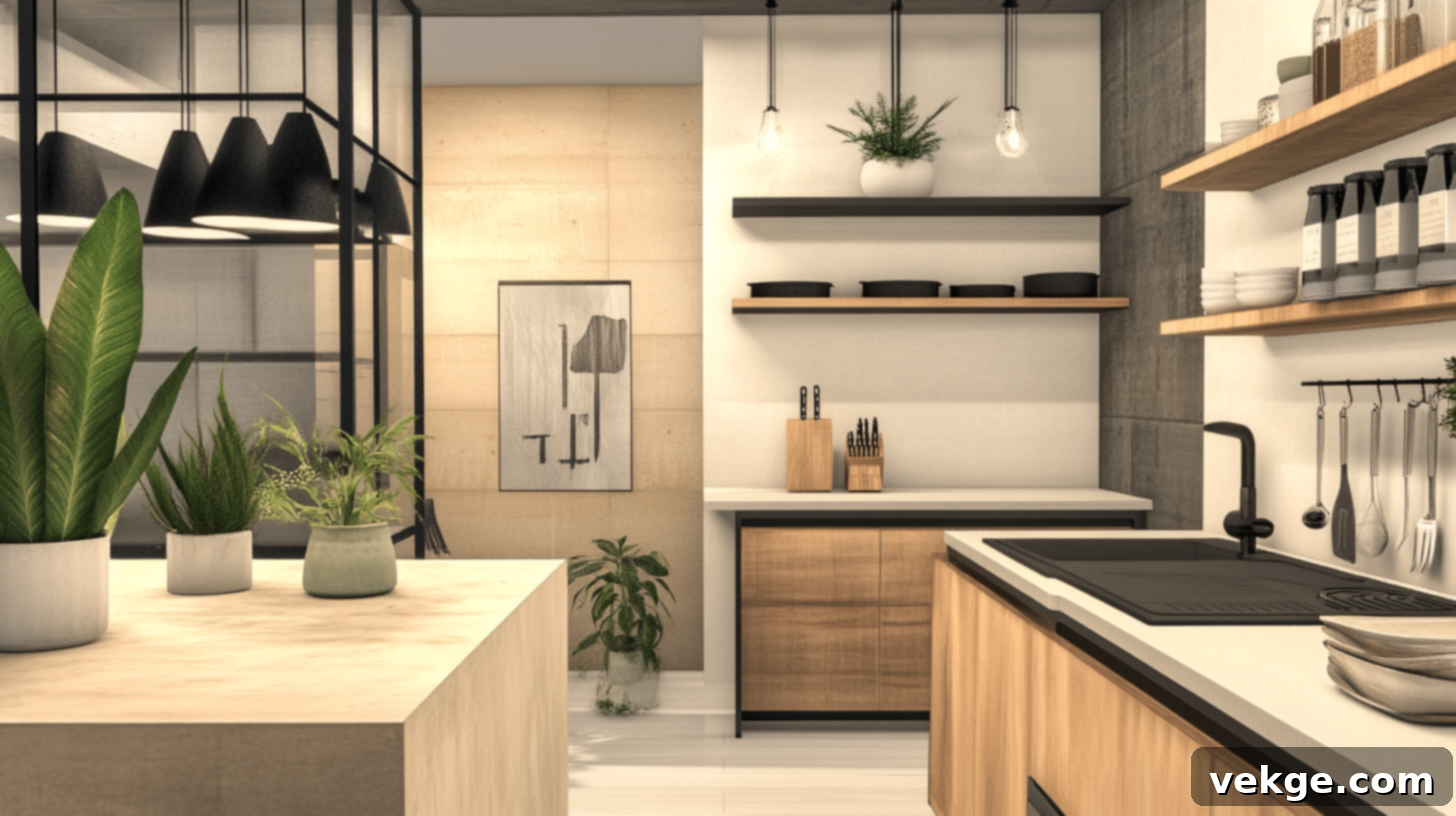Japandi Kitchen Design: Create a Serene & Stylish Cooking Sanctuary
Are you envisioning a kitchen space that exudes both simplicity and elegance? Japandi kitchen design might be the perfect aesthetic to transform your culinary haven. This unique style seamlessly fuses the minimalist philosophy of Japanese design with the warm, rustic elements of Scandinavian living, culminating in a cooking area that is both clean and incredibly calming.
In this comprehensive guide, we will delve into the core principles that define Japandi, explore how to master its essential components like natural wood and stone, and provide practical tips to effortlessly integrate this appealing style into your own kitchen. We’ll share expert advice on selecting the right colors, optimizing lighting, and crafting an intelligent layout to help you design a kitchen that feels simultaneously inviting and impeccably organized. Prepare to discover how this harmonious blend of Eastern tranquility and Northern comfort can elevate your kitchen’s aesthetics and functionality.
Understanding the Essence of Japandi Design
Japandi design represents a beautiful marriage of Japanese wabi-sabi aesthetics and Scandinavian hygge (or lagom, for balance). This inspiring blend emerged from a shared appreciation for simple living, natural materials, and meticulous craftsmanship. Both design philosophies prioritize functionality, clean lines, and a deep connection to nature, making their fusion feel incredibly organic and cohesive.
Japandi interiors are characterized by their uncluttered appearance, where every item has a purpose and contributes to the overall tranquility. The style thoughtfully incorporates organic materials such as light and dark woods, rough-hewn stone, and natural plant elements. It deliberately keeps things basic, focusing on quality over quantity and encouraging a mindful approach to home decor.
The primary objective of Japandi is to strike a perfect balance between the cozy comfort of Nordic design and the refined simplicity of Japanese minimalism. The color palette typically remains soft and muted, predominantly featuring whites, creams, warm grays, soothing greens, and earthy browns, often contrasted with subtle hints of black. This creates a serene backdrop that promotes relaxation and a sense of peace within the space.
In a Japandi room, visual clutter is actively avoided. Each piece of furniture or decor is carefully chosen for its form, function, and ability to contribute to a peaceful atmosphere. This intentional curation helps to create an open, airy, and truly tranquil home environment, perfectly suited for the heart of your home – the kitchen.
Transform Your Kitchen: Inspiring Japandi Kitchen Ideas
Ready to infuse your kitchen with the calming essence of Japandi? Here are 37 practical and beautiful ideas to get you started:
1. Layer Your Lighting for Ambiance and Function
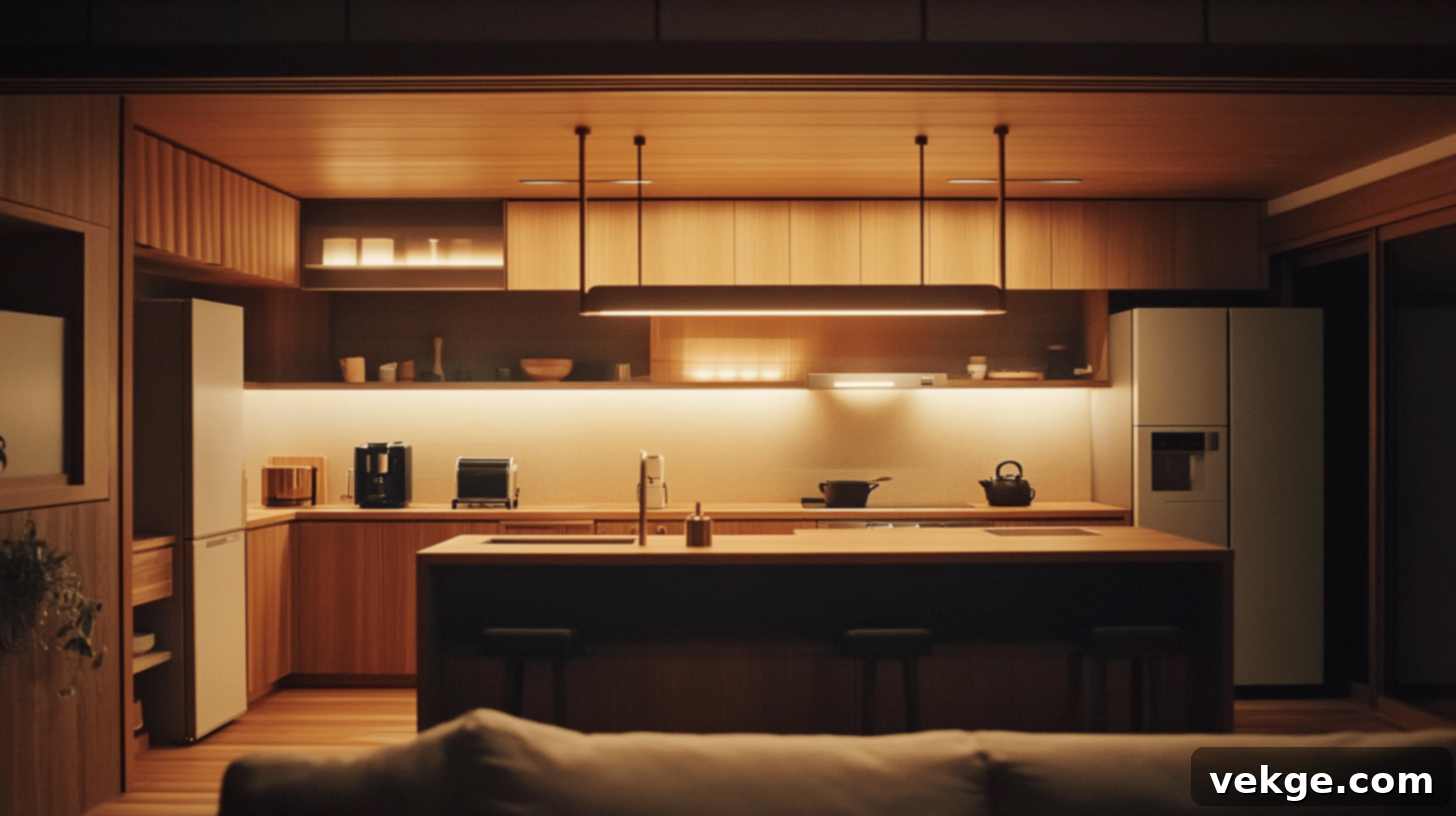
Effective lighting is crucial in any kitchen, and in Japandi design, it’s about creating warmth and versatility. Mix overhead ceiling lights for general illumination with smaller, focused lamps at counter level for task lighting. Consider adding subtle LED strip lights under cabinets or behind shelves, and even incorporate candles or dimmable sconces for an extra layer of cozy ambiance. This layering ensures both functional brightness for cooking and a soft, inviting glow for dining and relaxation.
2. Warm Up the Space with Cozy Textures

To soften the often-hard surfaces of a kitchen, introduce a variety of natural, cozy textures. Think soft linen dish towels, artisanal wooden cutting boards, and beautifully crafted clay pots or ceramic dinnerware. A small, simply patterned rug made from natural fibers like jute or wool placed near the sink can add a tactile element underfoot, making the space feel more lived-in, comfortable, and inviting without introducing unnecessary clutter.
3. Embrace the Wood Theme Throughout Your Kitchen
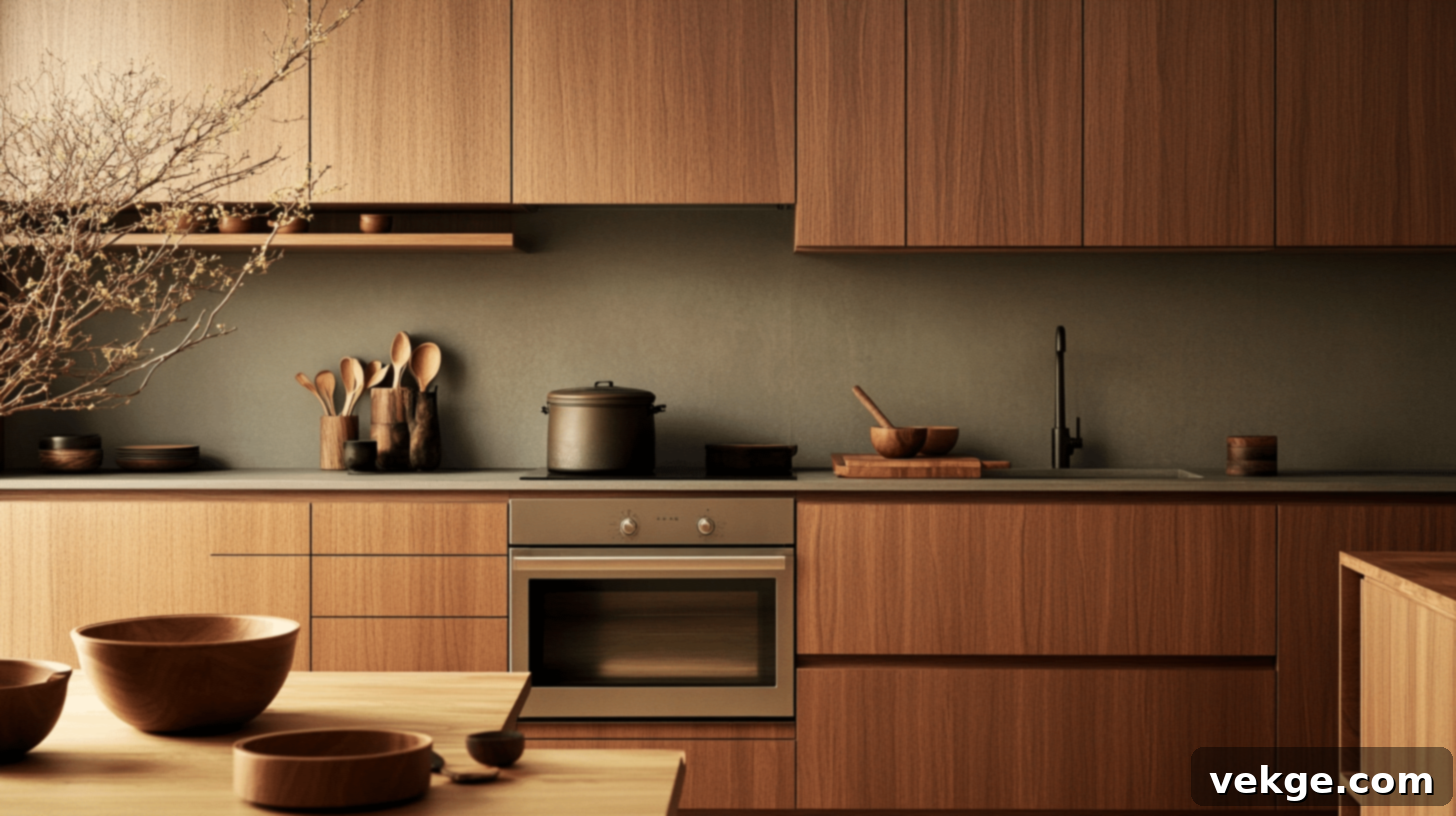
Wood is a cornerstone of Japandi design, bringing natural warmth and texture. Utilize it extensively for flooring, custom cabinetry, open shelving, and even smaller decorative or functional items like serving spoons, bowls, and placemats. Experiment with mixing lighter woods such as pale oak or birch with darker tones like walnut or teak to create depth and visual interest. Always opt for matte or satin wood finishes over glossy ones to highlight the natural grain and beauty of the timber, reinforcing an organic and authentic feel.
4. Bring in Stone for Organic Texture and Durability
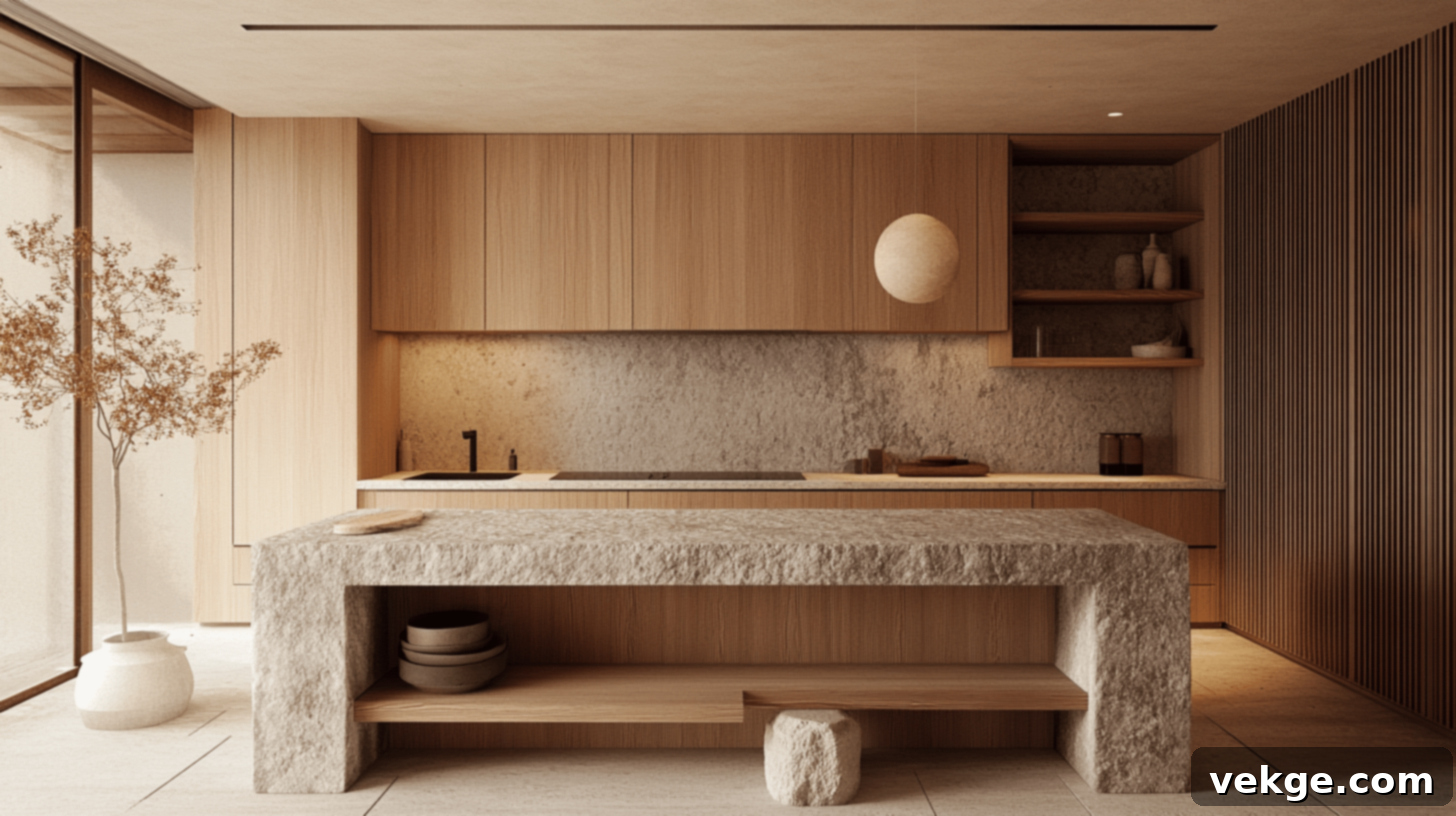
Stone elements provide a beautiful contrast to warm woods and add a touch of earthy sophistication. Choose stone countertops, backsplashes, or even flooring that showcases natural marks, subtle veining, and organic textures. Colors like soft gray, understated tan, or creamy off-white complement a Japandi palette beautifully and integrate seamlessly with wood tones. Stone not only adds a cool, grounding balance but is also incredibly durable and easy to maintain, making it a practical and aesthetic choice for the kitchen.
5. Go Dramatic with a Strategic All-Black Accent
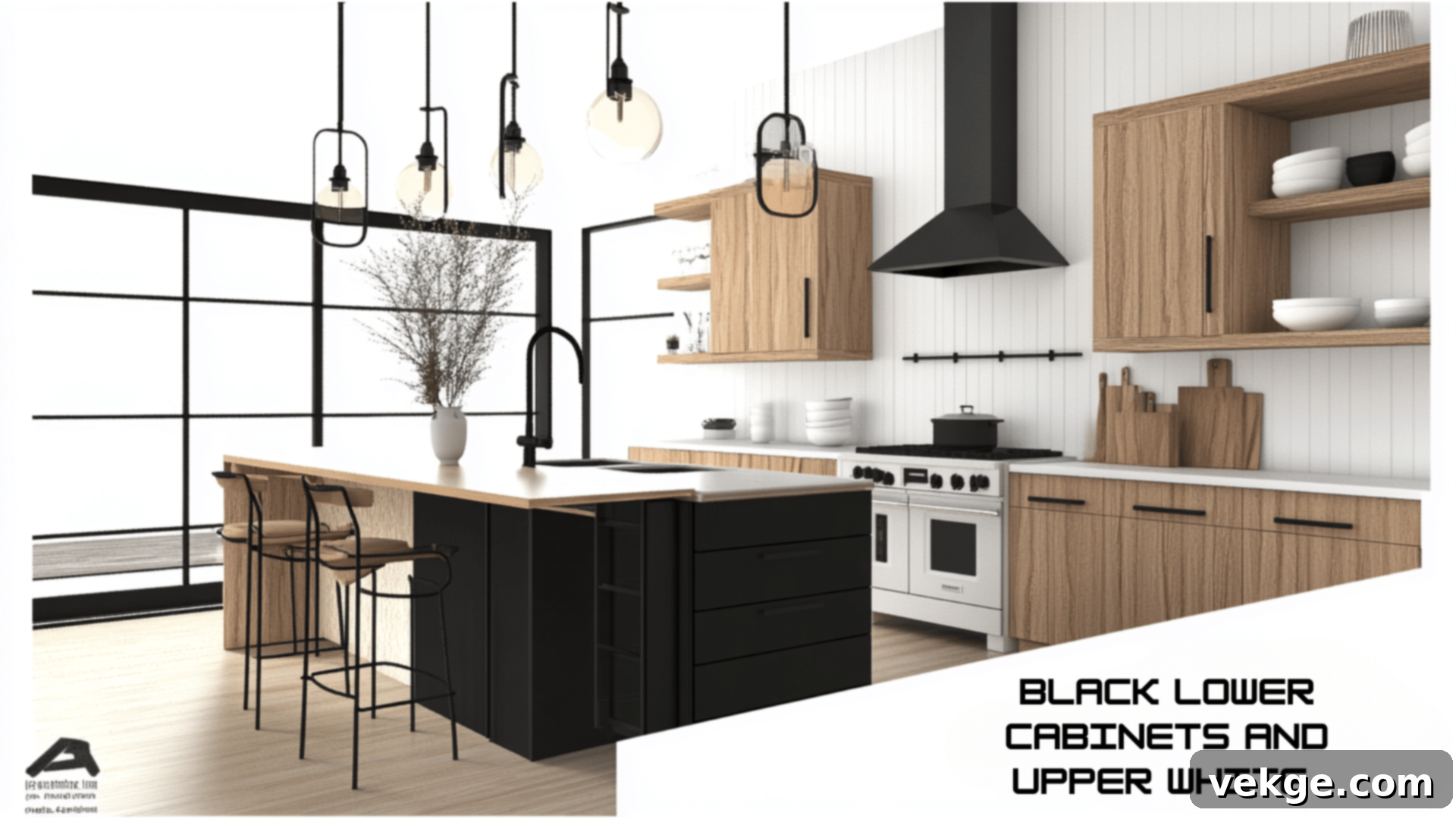
While Japandi favors light and natural tones, a strategic touch of black can add drama and definition without overwhelming the space. Consider painting lower cabinets in a deep matte black, while keeping upper cabinets white or a light wood. Incorporate black metal light fixtures, minimalist hardware, or even black accents in cookware. When paired with ample natural light and balanced with warmer elements, this contrast creates a sophisticated and modern edge without making the kitchen feel dark or heavy.
6. Incorporate a Large Statement Plant
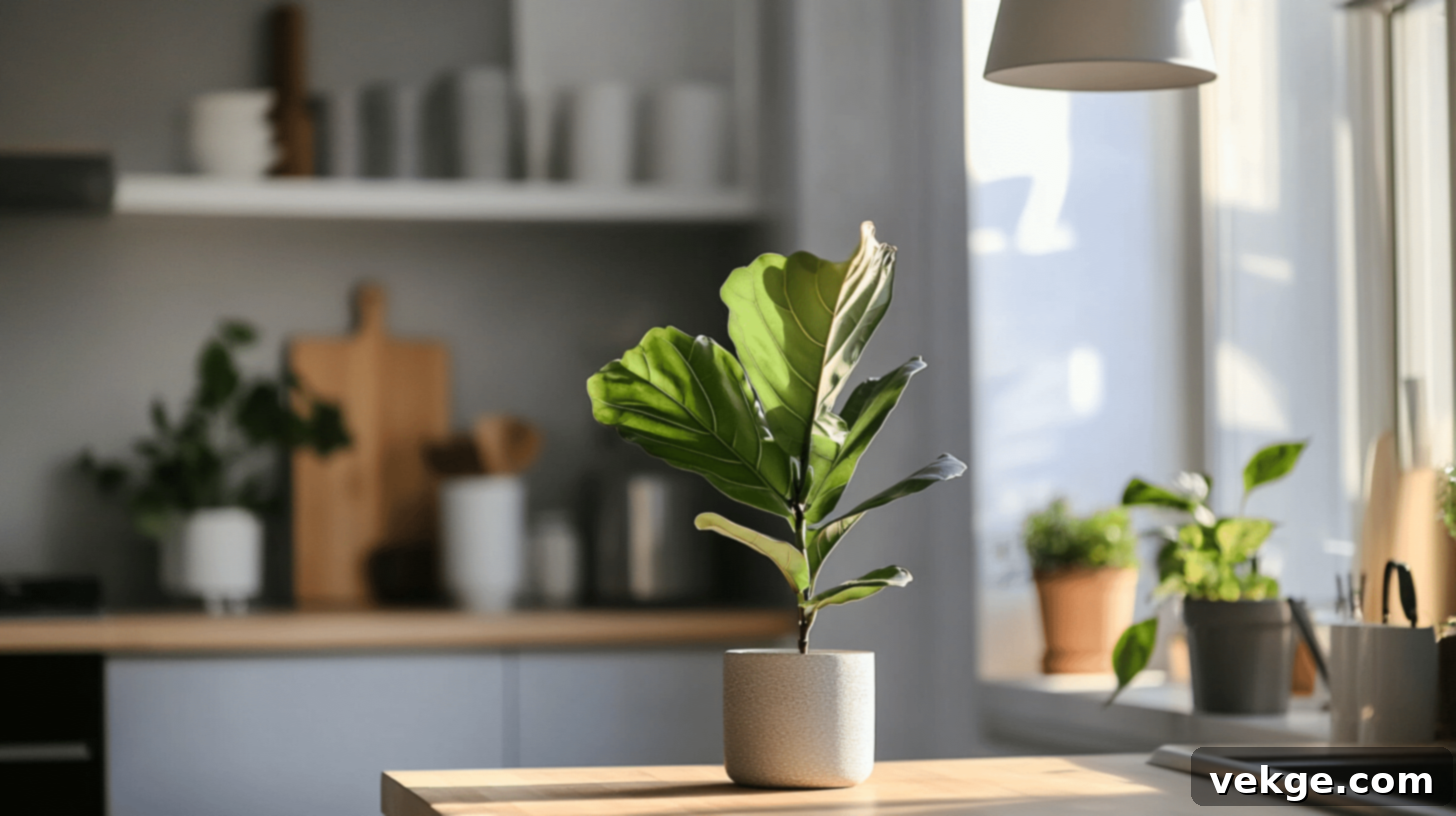
Bringing nature indoors is a key tenet of Japandi design. Choose one prominent, low-maintenance statement plant, such as a tall fiddle leaf fig, a striking snake plant, or a graceful olive tree, and place it in a simple, unglazed ceramic or concrete pot. This adds a vibrant splash of life and natural color, providing a refreshing contrast to the neutral palette and wooden elements. It introduces biophilic design principles, enhancing the overall sense of calm and well-being.
7. Focus on a Minimalist Backsplash
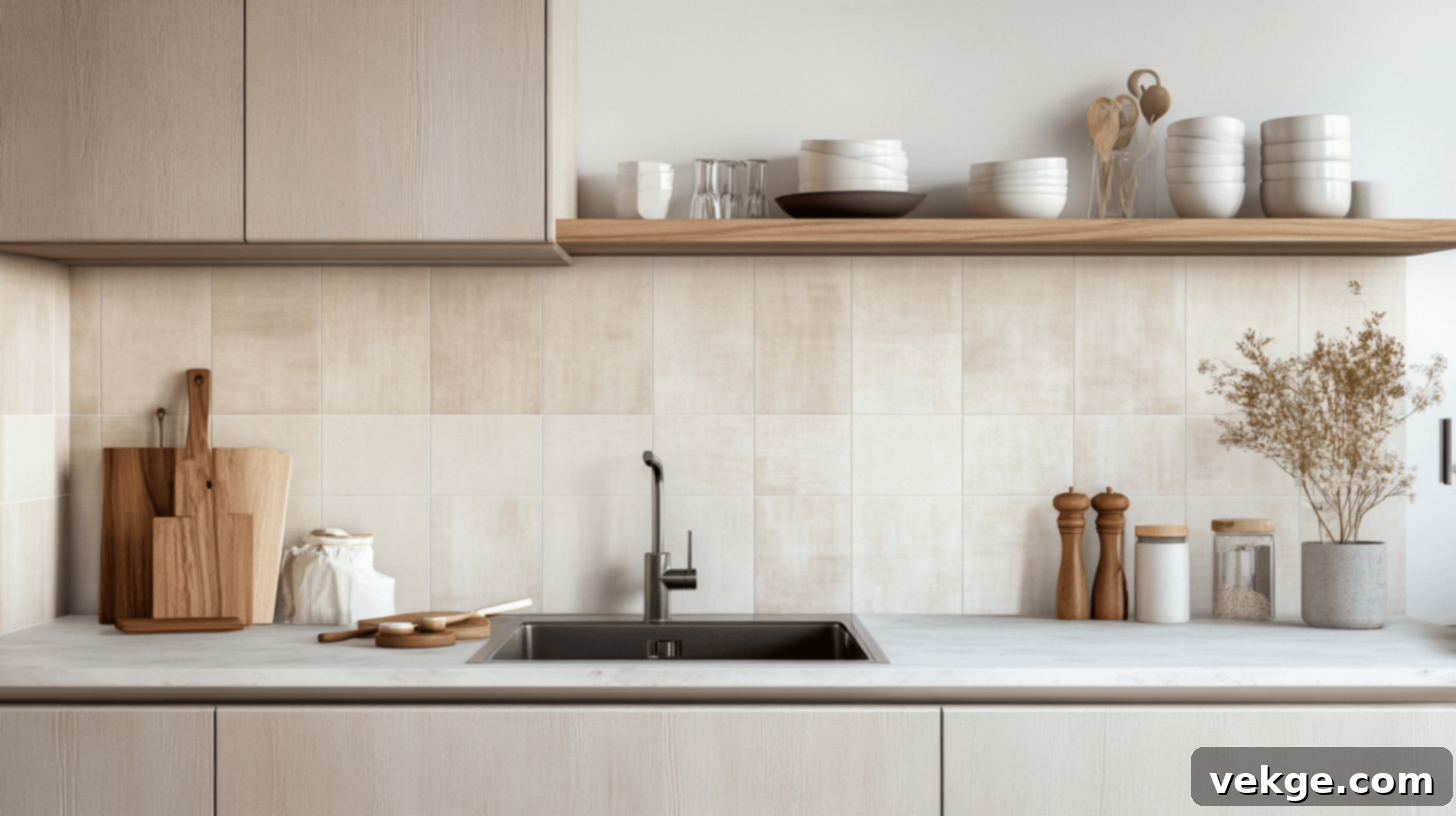
The backsplash offers an opportunity to add subtle texture and character without disrupting the serene flow. Select simple, understated tiles in a single, neutral color, or opt for a natural stone slab with subtle veining. Arrange tiles in a clean, straightforward pattern like a classic subway stack, a straight bond, or a vertical stack. This approach creates visual interest and defines the cooking area while maintaining the uncluttered, easy-to-clean aesthetic that is central to Japandi design.
8. Go All Out with Functional Minimalism
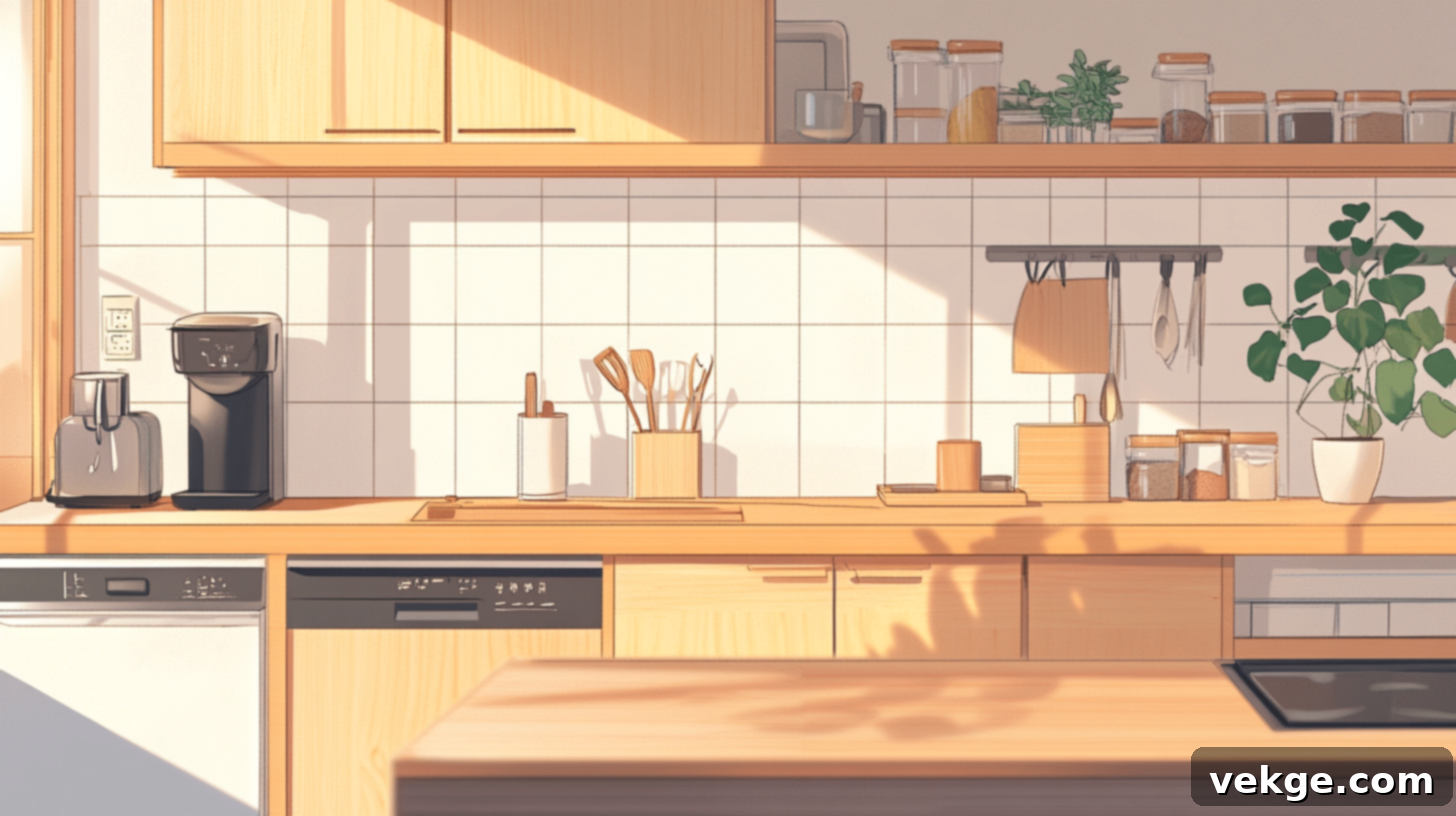
Embrace true minimalism by keeping kitchen counters as clear as possible. Design thoughtful storage solutions to hide away small appliances, utensils, and food items. Opt for handleless cabinet fronts (push-to-open mechanisms are ideal) to create an unbroken, seamless look. This extreme focus on simplicity and tidiness cultivates an exceptional sense of calm and makes even the smallest kitchens feel significantly larger, more open, and incredibly organized.
9. Select Sleek, Matte Surfaces
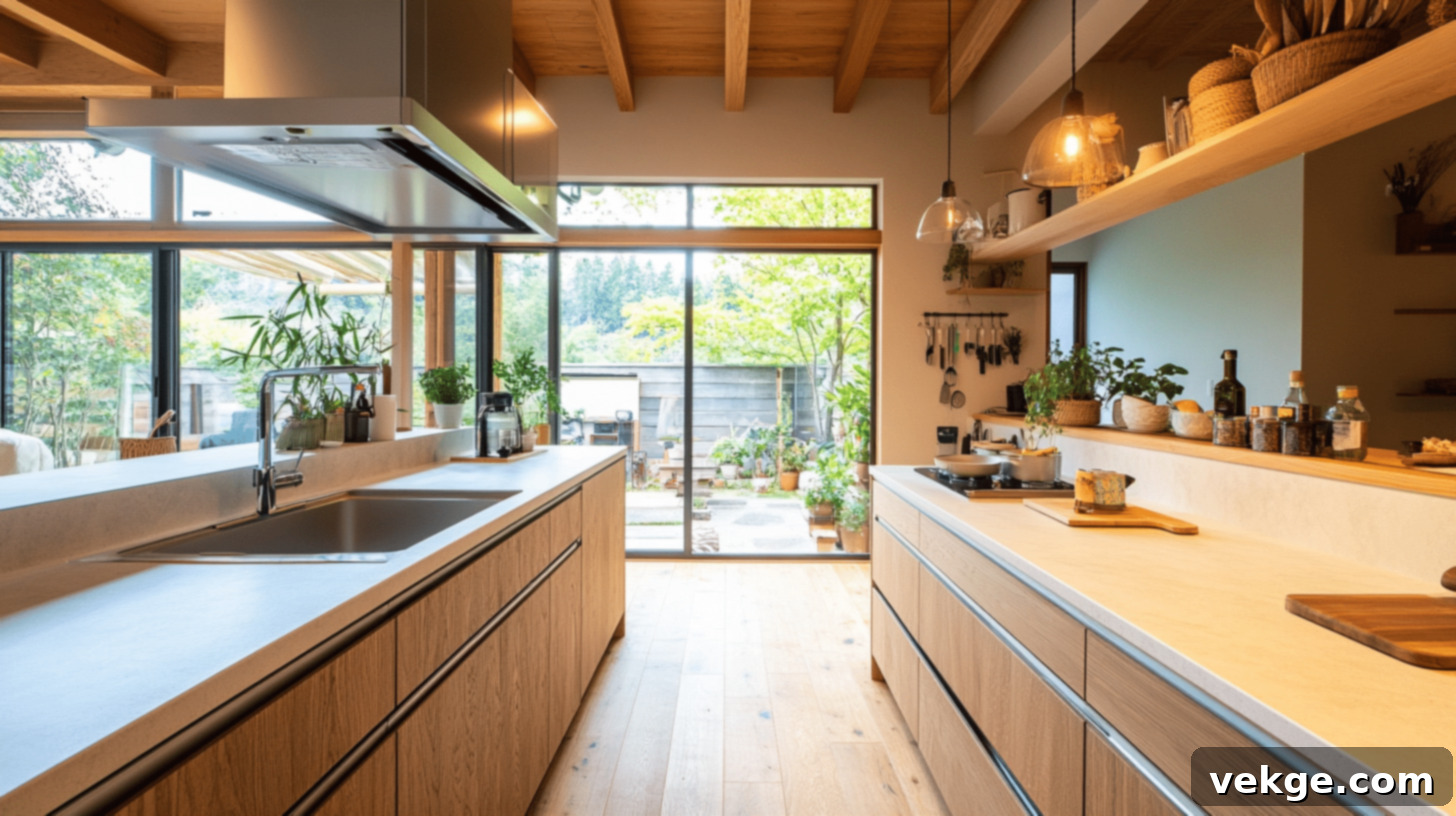
In Japandi design, the texture and finish of surfaces are paramount. Choose matte finishes over glossy ones for cabinets, countertops, and appliances. Look for smooth, flat-front cabinet doors and drawers, avoiding any intricate paneling, bevels, or fancy edge details. This creates a highly refined, clean-lined aesthetic that feels incredibly modern and sophisticated while still conveying warmth through the use of natural materials like wood and stone.
10. Stick with Simple, Uncluttered Lines

Simplicity in form is a hallmark of Japandi. Select cabinets, kitchen islands, and open shelving units with clean, straight edges and uncomplicated profiles. Steer clear of ornate carvings, excessive trim, or overly decorative elements. This commitment to simple lines creates a sense of visual tranquility, allowing the quality of the materials and the functionality of the space to take center stage, resulting in a kitchen that feels both modern and enduringly timeless.
11. Define Layers and Height in the Space
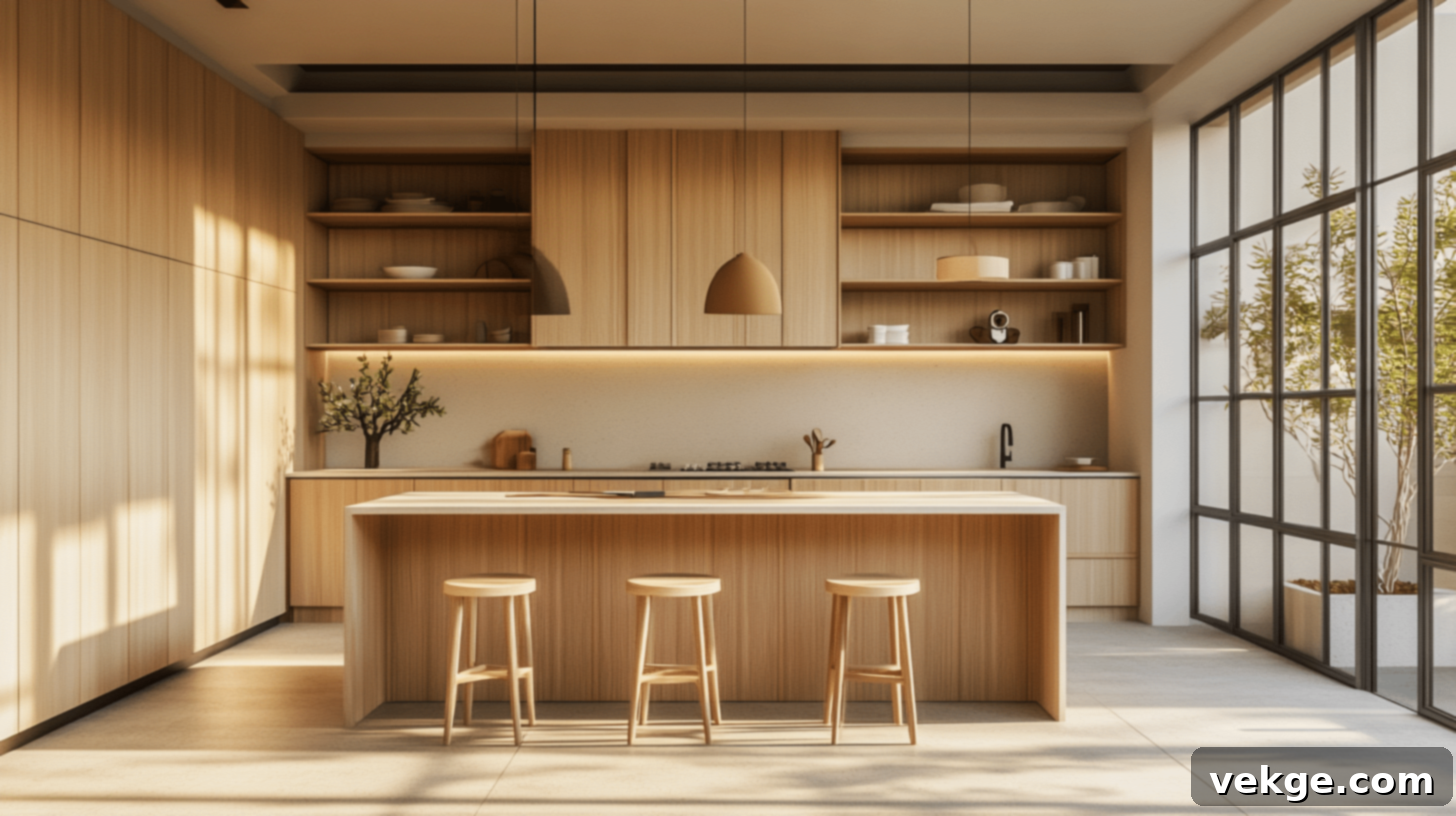
Create visual interest and depth by employing varying heights within your kitchen. Incorporate low stools at an island, mid-height countertops, and taller cabinets or open shelving. This intentional layering adds dimension without introducing clutter, guiding the eye smoothly through the space. Ensure each layer serves a clear purpose and that there is ample breathing room around each element, contributing to an open and balanced feel.
12. Add Metallics for a Subtle Traditional Twist

Introduce small, carefully chosen touches of metallic finishes to add a hint of refined elegance. Consider warm metals like brushed brass, antiqued copper, or subtle bronze for light fixtures, cabinet pulls, or the kitchen faucet. Keep the shapes and designs of these metallic items very simple and clean. The rich, warm tones of these metals beautifully complement natural woods and add a subtle, sophisticated shimmer that enhances the overall aesthetic without being ostentatious.
13. Be Intentional with Decor and Accessories

In Japandi design, less is always more when it comes to decor. Choose only 3-5 carefully selected items to display on open shelves or countertops. Each piece should possess personal meaning, exceptional craftsmanship, or a clear functional purpose. A hand-carved wooden bowl, a unique ceramic vase with a single branch, or a beautifully textured, handmade mug can add depth and personality without making the space feel visually busy or cluttered. Quality over quantity is key.
14. Use Symmetrical Tiles for a Harmonious Look
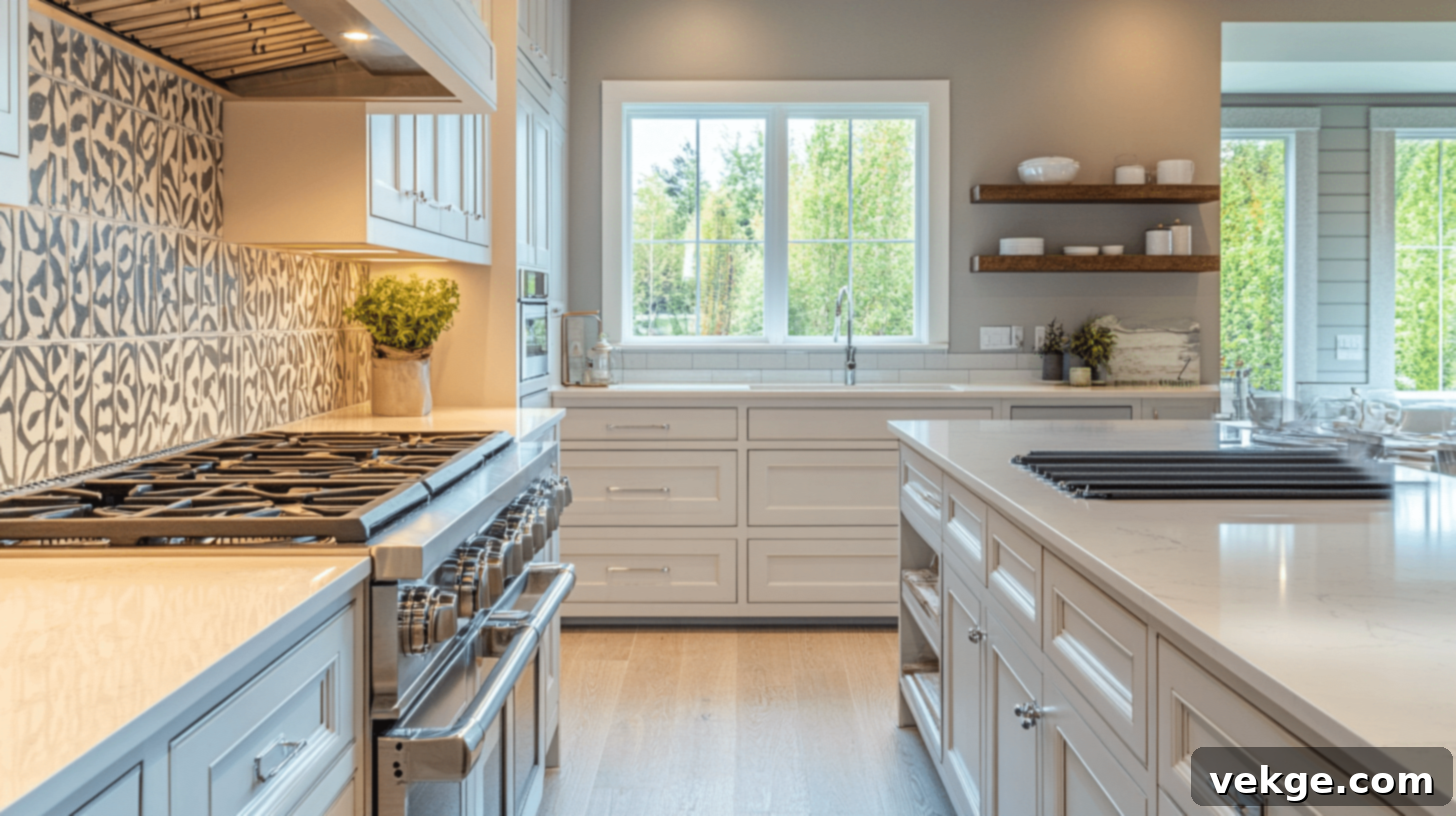
For your backsplash or any tiled areas, opt for tiles with symmetrical shapes, such as perfect squares or clean rectangles. Arrange them in even, balanced patterns like a classic grid or a precise running bond. This creates a sense of order and harmony, adding a subtle layer of texture without introducing visual noise. The consistent lines reinforce the clean, calming feeling that is so characteristic of the Japandi style, making it both aesthetically pleasing and easy to clean.
15. Add a Subtle Coastal Spin
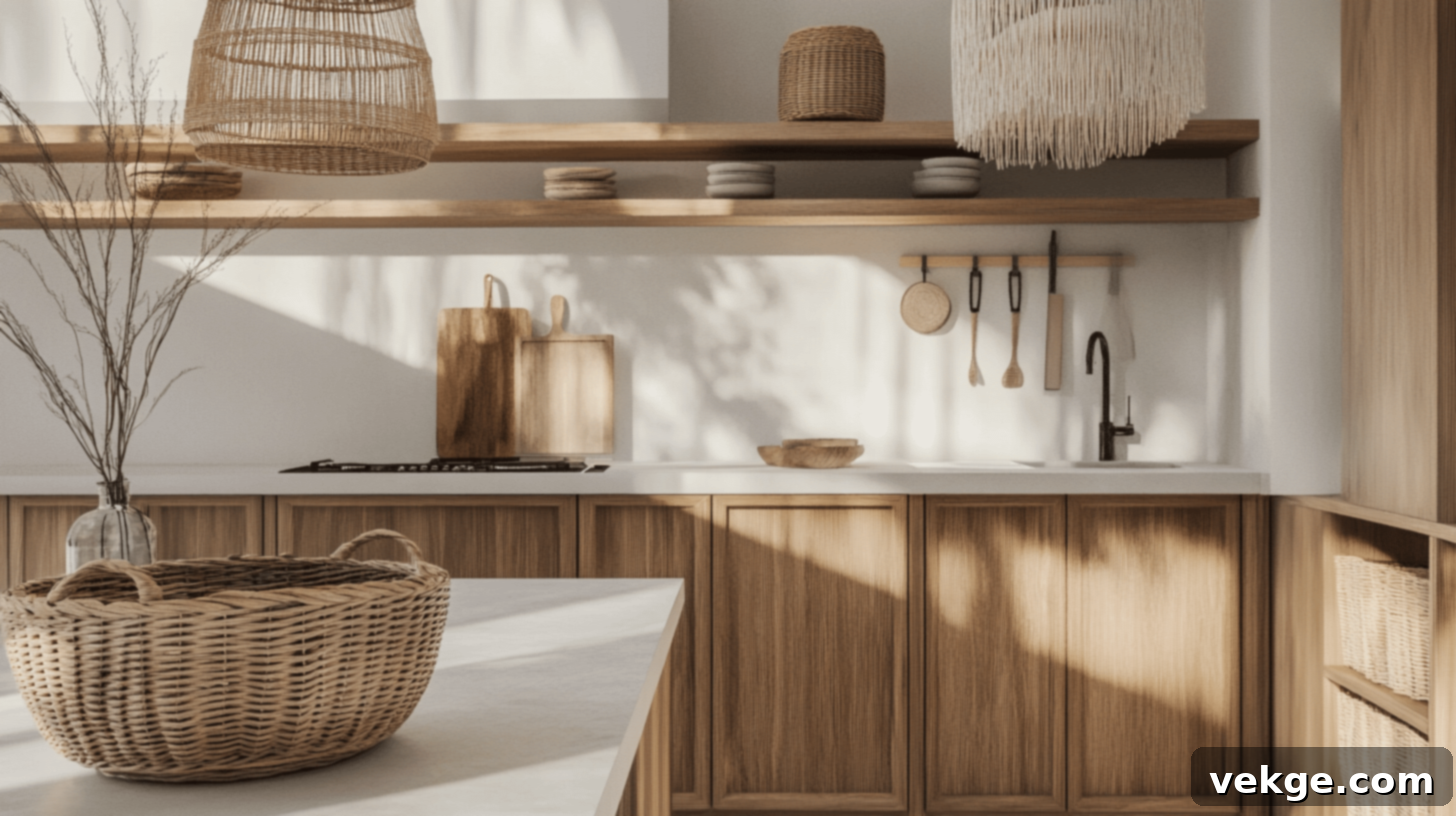
Introduce a gentle coastal influence by incorporating muted shades of light blue, soft seafoam green, or sandy tans alongside your foundational wood and white elements. Accent with natural textures like braided rope details, woven seagrass baskets, or ceramics reminiscent of beach stones. This subtle coastal touch aligns beautifully with Japandi’s appreciation for nature and organic materials, adding a refreshing, airy feel while strictly adhering to the principles of simplicity and clean lines.
16. Hone in on a Neutral Color Palette

The foundation of a Japandi kitchen’s color scheme should be built around a palette of sophisticated neutrals. Focus on varying shades of whites, creams, warm grays, light tans, and strategic touches of black. Layer in the rich, organic tones of different woods to introduce warmth and depth. This limited, carefully curated color scheme creates an immediate sense of calm and openness, making the space feel serene, expansive, and effortlessly adaptable to minor decorative changes over time.
17. Center Minimalism into Other Areas

Extend the serene, minimalist Japandi aesthetic beyond the kitchen and into adjacent dining or living areas. Opt for simple, understated table settings, clean-lined bench seating, and uncluttered tabletops. This design continuity creates a seamless flow between different zones of your home, reinforcing a cohesive and harmonious design narrative. The consistent application of Japandi principles ensures every space feels intentional, tranquil, and interconnected.
18. Keep Patterns Consistent and Subtle
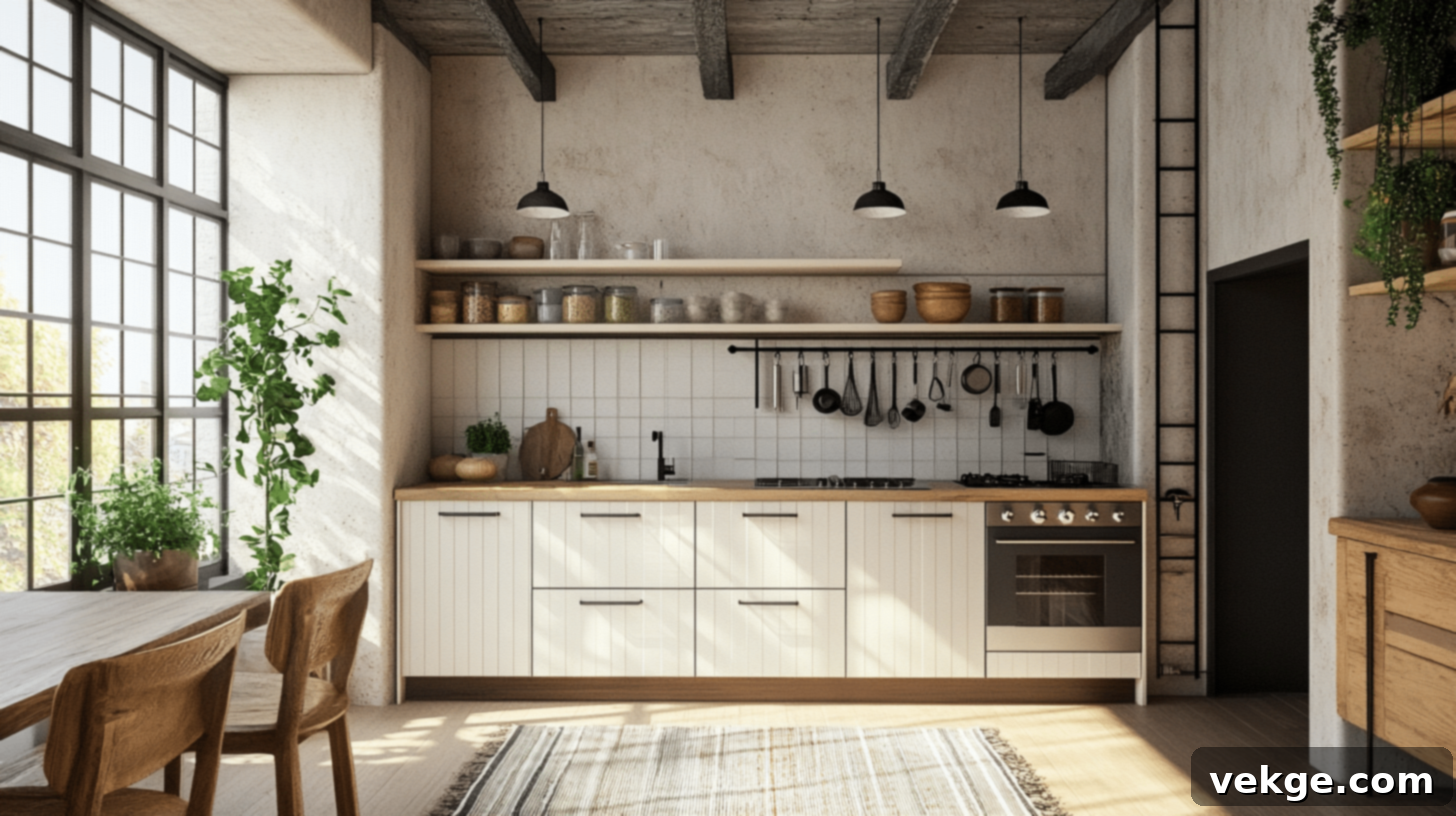
When incorporating patterns, ensure they are used sparingly, subtly, and consistently. For example, a simple linear pattern on a small kitchen rug might be echoed in the weave of dish towels or the subtle texture of a ceramic planter. This thoughtful repetition creates visual unity and a sense of calm without making the space feel busy or chaotic with multiple competing designs. Patterns should enhance, not distract from, the overall tranquility.
19. Match the Tone of the Wood with Other Colors
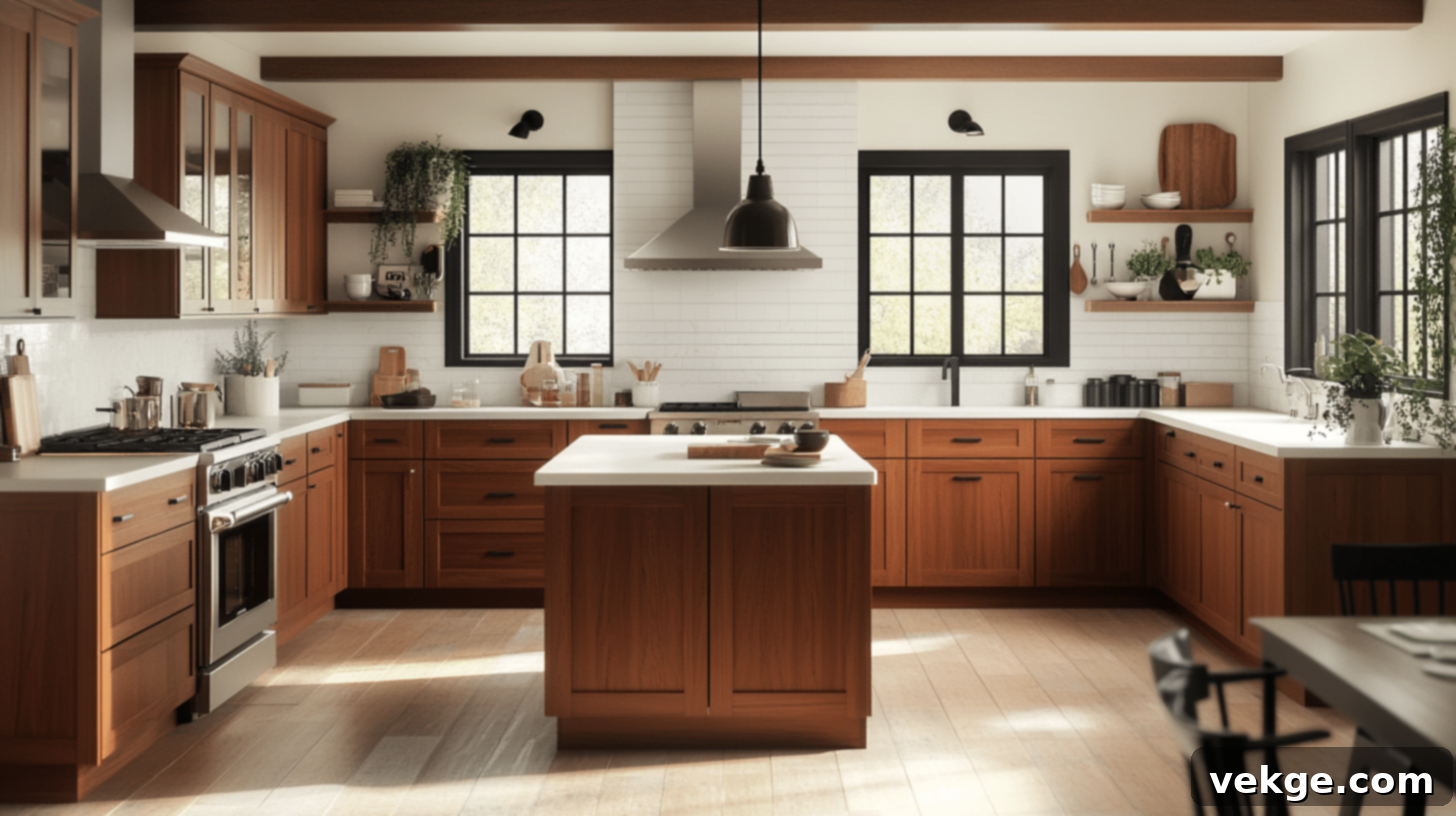
Achieve a harmonious look by carefully selecting paint colors and other finishes that share the same underlying warm or cool tones as your chosen wood. Warm woods, like oak or walnut, pair beautifully with creamy whites, soft off-whites, and earthy beiges. Conversely, cooler woods, such as ash or light birch, complement crisp whites, pale grays, and cool-toned greens. This attention to underlying tones creates a smooth visual transition and a cohesive, well-balanced aesthetic throughout the kitchen.
20. Balance Black and White for Definition
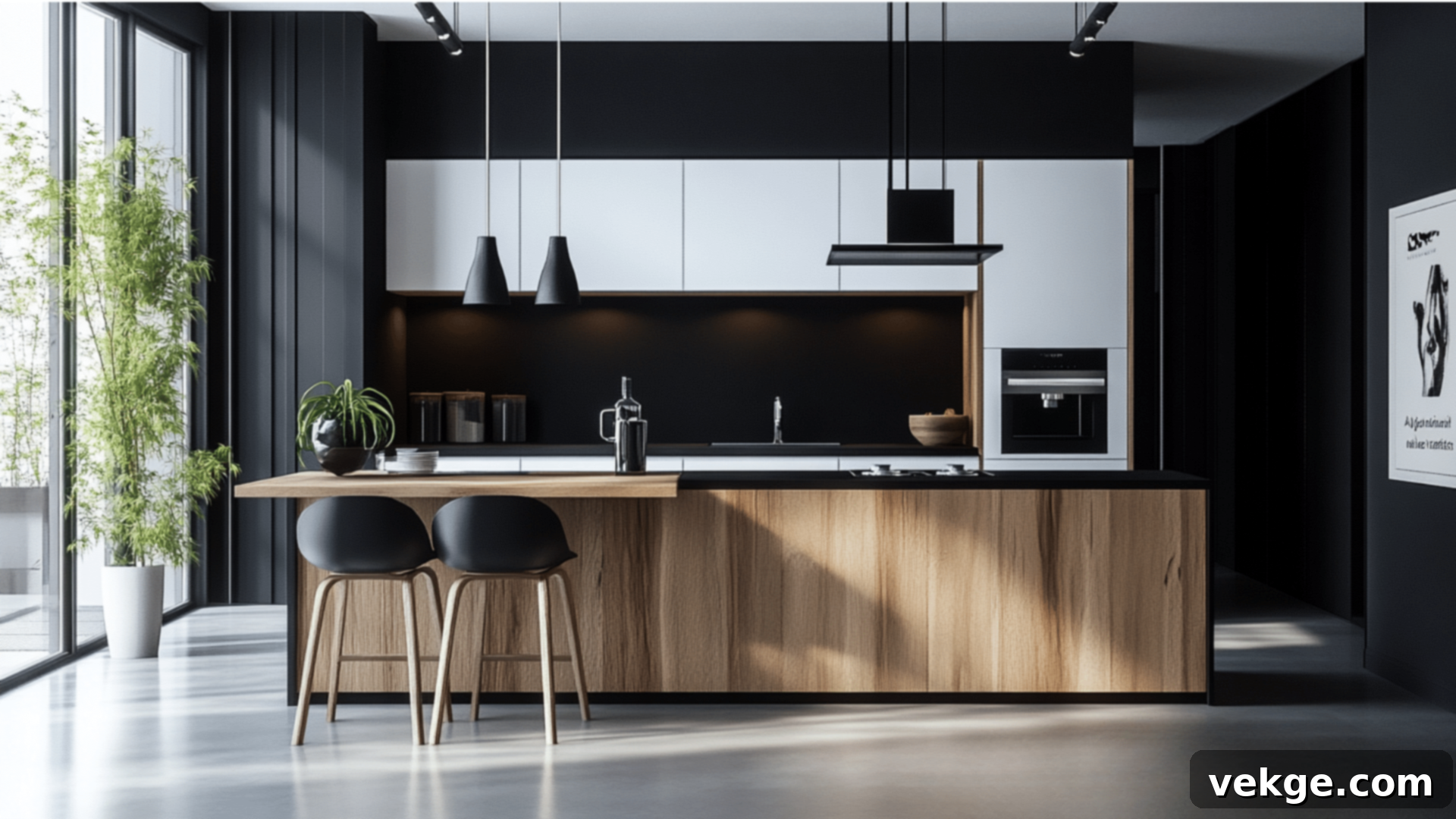
A classic and effective Japandi technique involves strategically balancing black and white elements. Use black as a grounding accent on lower cabinets, kitchen islands, or base elements, providing a strong anchor to the room. Reserve white for upper cabinets, walls, and ceiling, ensuring the space feels open and airy. Introduce natural wood in the middle layers, such as countertops or open shelving, to gracefully bridge the two contrasting tones and infuse essential warmth, creating a sophisticated and balanced visual.
21. Play with a Single Color for a Unique Finish
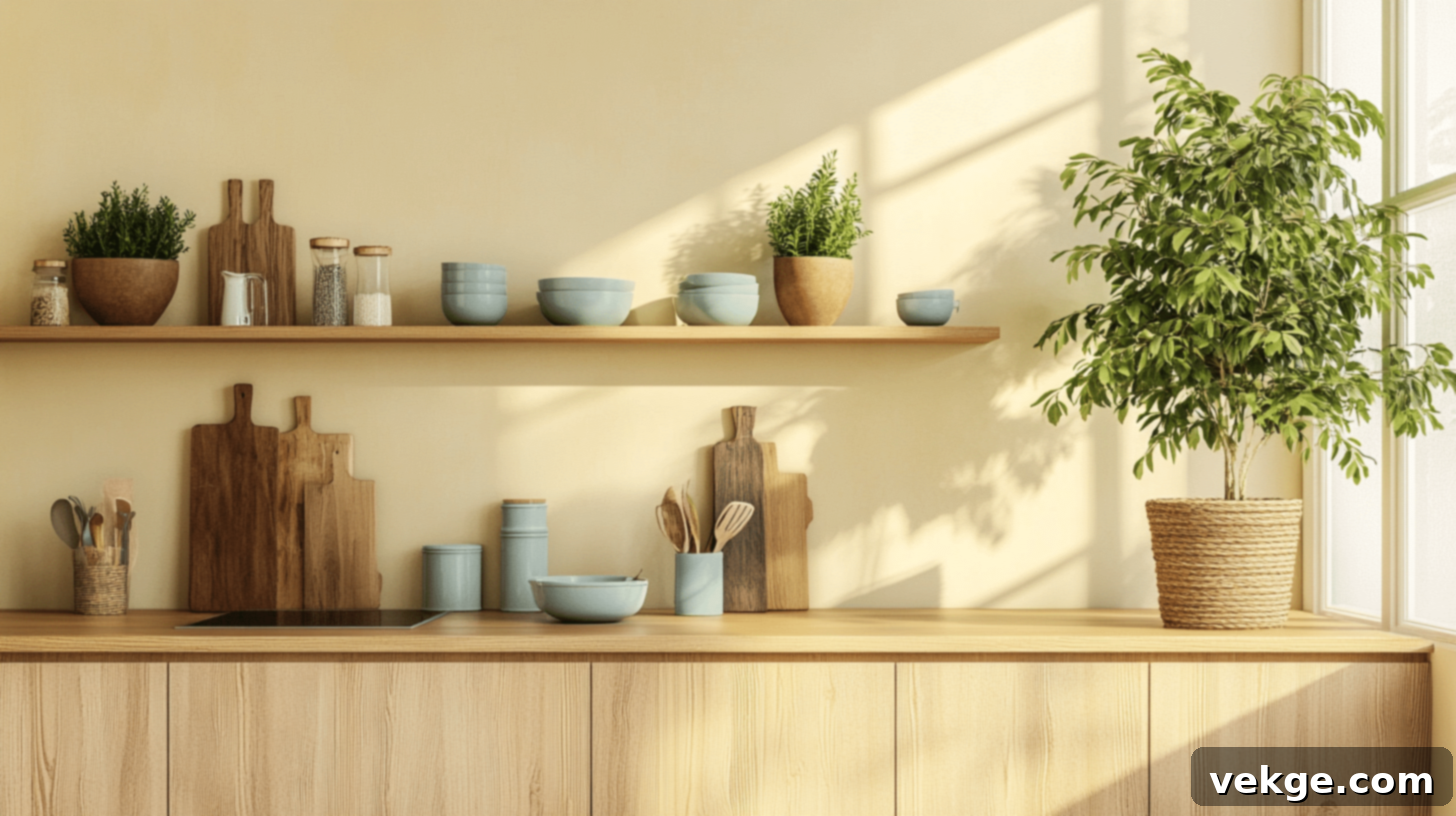
While neutrals form the core, a single, carefully chosen bold color can add a personalized touch. Introduce this accent color in small, deliberate doses – perhaps through a set of ceramic cups in a muted forest green, a single deep blue plant pot, or an earth-toned piece of artwork. Ensure the chosen color maintains a natural, subdued tone rather than being overly vibrant. This thoughtful pop of color stands out beautifully and adds character when the rest of the space adheres to a calming, neutral palette.
22. Consider Sleek, Unobtrusive Light Fixtures
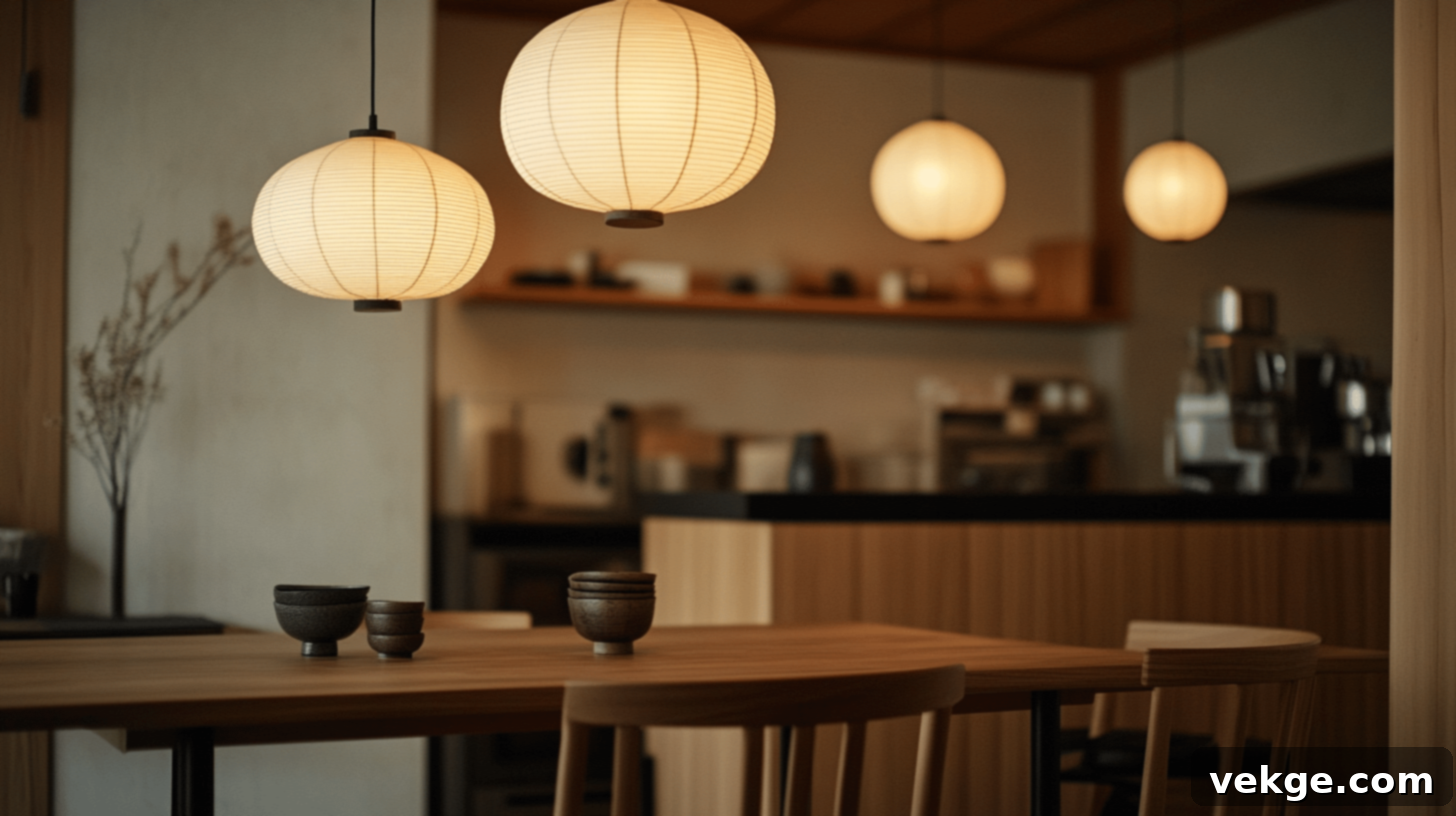
Light fixtures in a Japandi kitchen should be functional, aesthetically pleasing, and minimalist in design. Opt for lights with simple, clean shapes crafted from natural materials like washi paper, natural wood, or sleek black metal. Avoid overly elaborate crystal chandeliers or highly decorative glass fixtures. The ideal Japandi lighting should integrate seamlessly into the overall design, providing illumination without drawing excessive attention, becoming a beautiful design element when noticed, yet subtle when not.
23. Hold Onto Consistent Details in Small Cooking Spaces
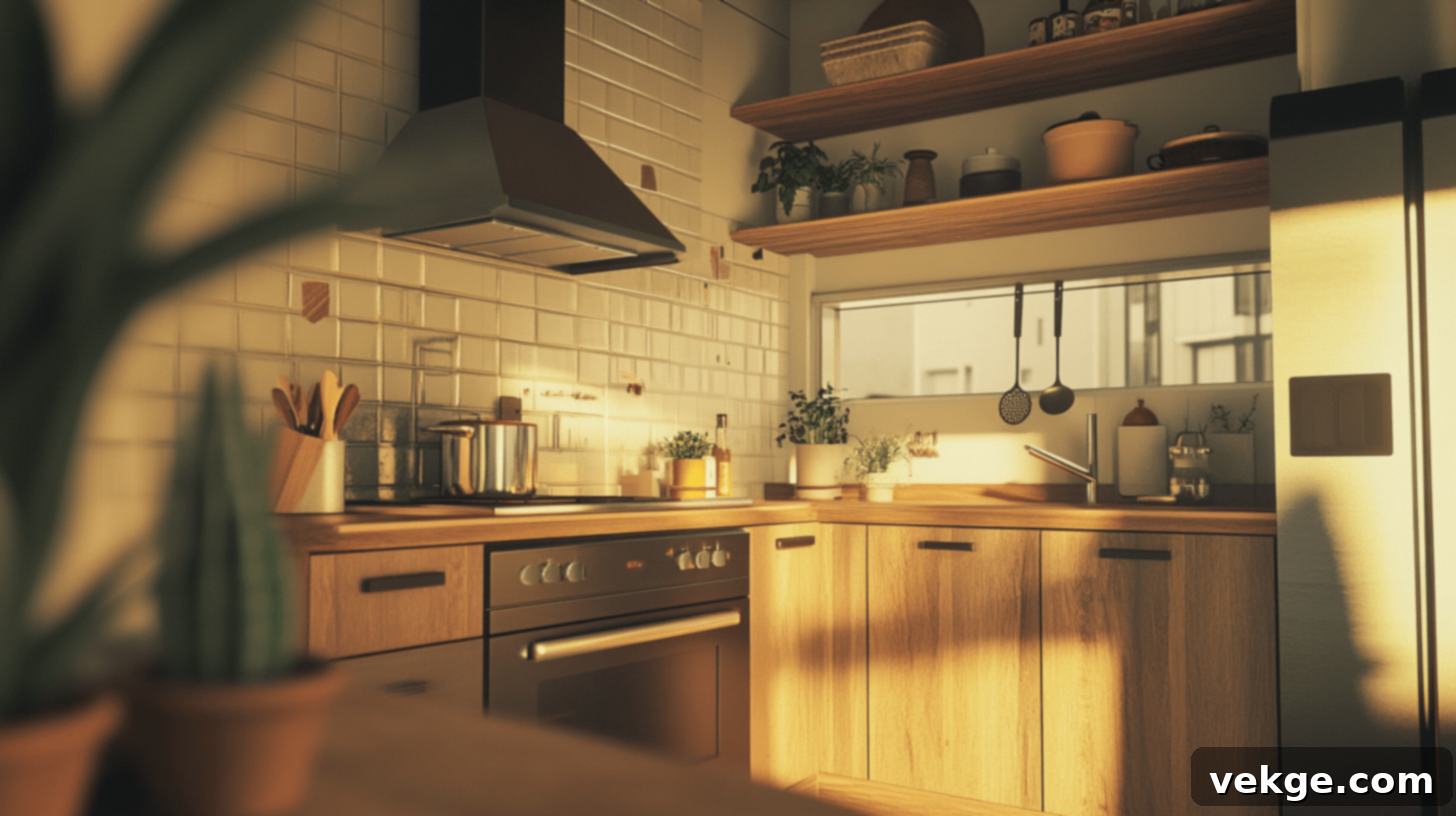
In compact kitchens, consistency is paramount to creating a sense of spaciousness and order. Maintain a uniform wood tone throughout, whether for cabinetry, flooring, or open shelving. Similarly, stick to a single metallic finish for all hardware and fixtures. This coherent approach minimizes visual breaks, making the small space feel larger, more streamlined, and thoughtfully designed, even within limited square footage.
24. Seek Out Unique, Handcrafted Details
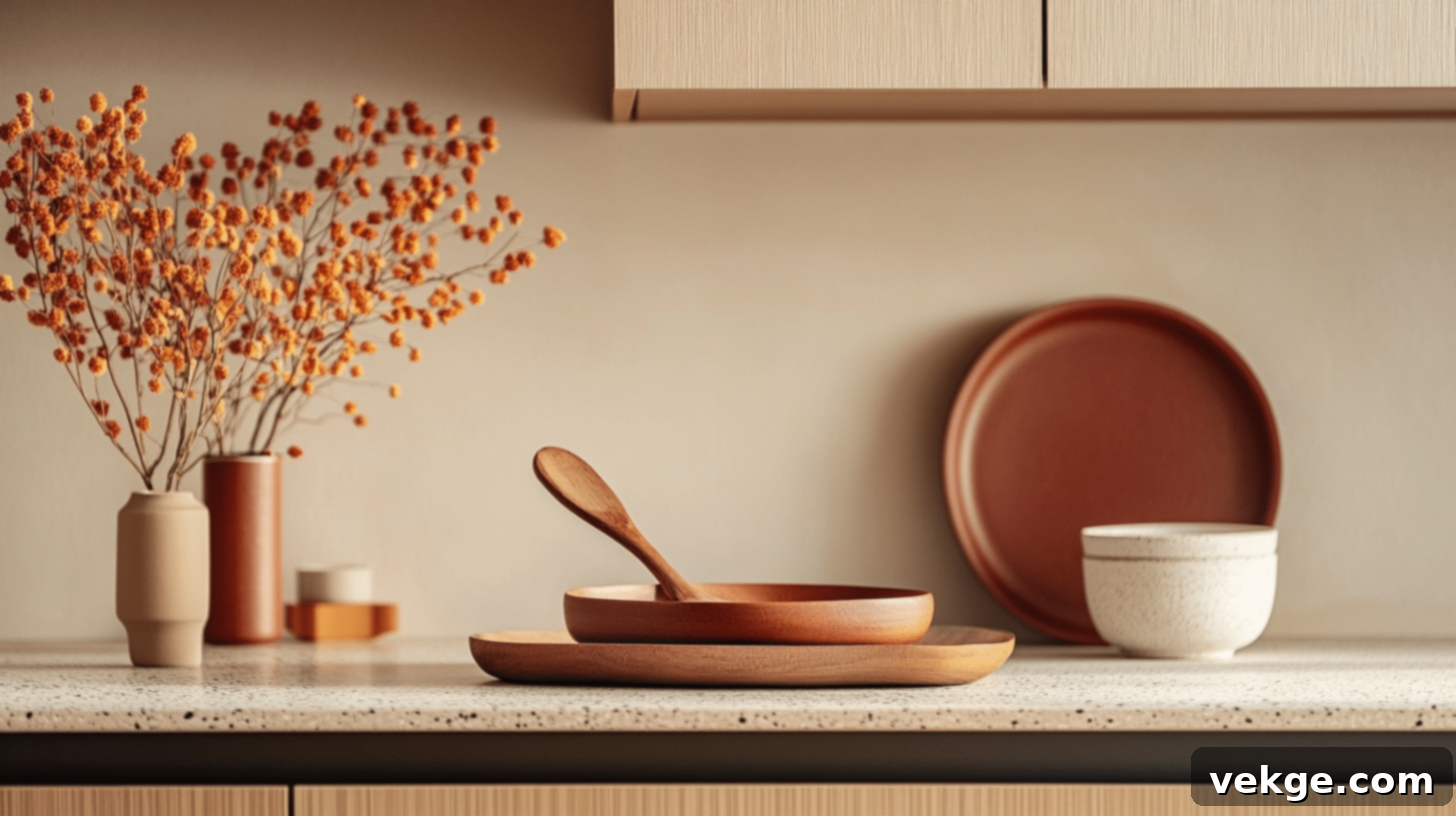
Incorporate one or two special, handcrafted items that celebrate human artistry and natural imperfections, embodying the wabi-sabi principle. This could be a unique, hand-carved wooden spoon rest, a set of artisan ceramic plates with a distinct texture, or a beautifully woven textile piece. These items should be simple in color but possess interesting shapes, tactile textures, or subtle irregularities that highlight their unique, handmade quality and add character without creating clutter.
25. Create Balance Across the Space
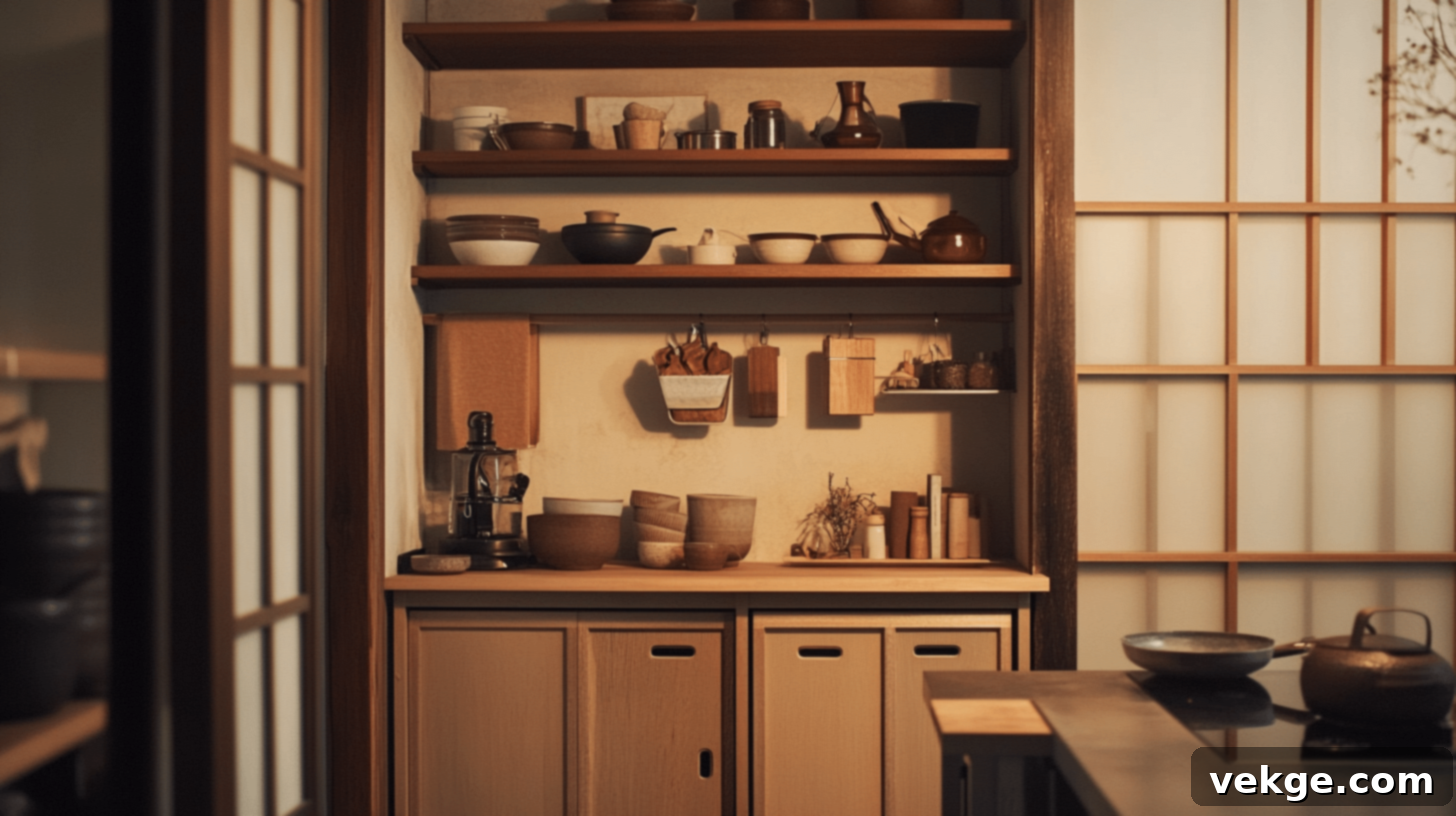
Achieve a sense of harmony and equilibrium by thoughtfully balancing elements throughout your kitchen. When possible, place items in pairs or use visual weight to create symmetry. For example, if a tall pantry cabinet anchors one side of the room, balance it with a set of vertical open shelves or a similarly weighted architectural feature on the opposite side. This intentional arrangement creates a purposeful and calm environment, moving away from random placement and fostering a deeply satisfying visual order.
26. Bring in Subtle Movement with Furniture and Decor
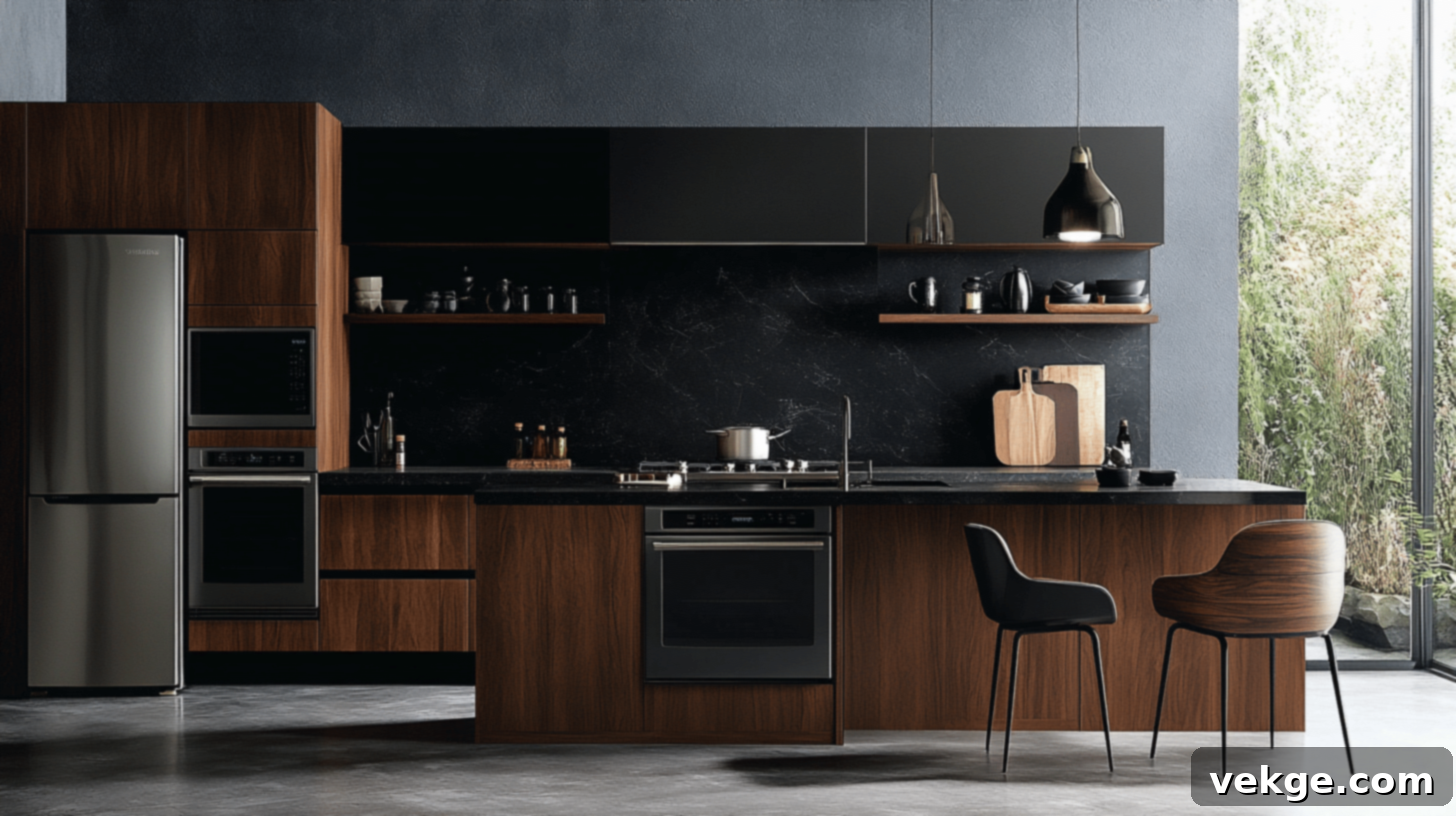
To prevent the clean lines from feeling too rigid, introduce subtle elements that suggest movement. Consider elegant swivel bar stools for your kitchen island or strategically placed pendant lights that cast interesting, shifting shadows as the day progresses. These small, dynamic elements add a touch of life and gentle energy to the otherwise still and clean space, ensuring it feels vibrant and lived-in without becoming busy or visually loud.
27. Don’t Forget the Appliances – They Should Blend In
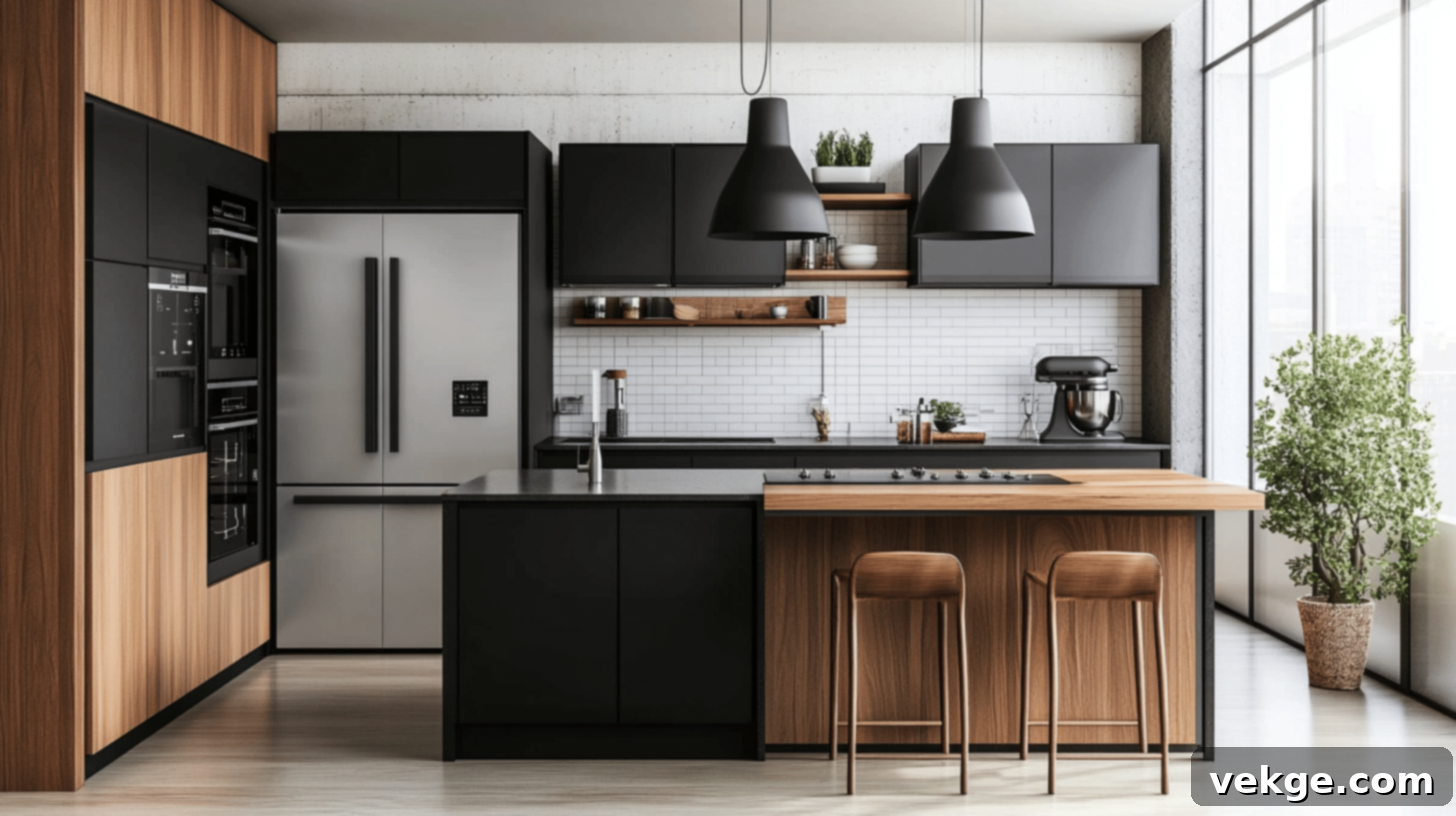
Appliances should be chosen to integrate seamlessly into the Japandi aesthetic, rather than standing out. Opt for models with sleek, minimalist fronts in neutral colors like matte black, crisp white, or brushed stainless steel. Whenever possible, hide smaller appliances such as blenders, toasters, and coffee makers within specially designed cabinets or pantry areas. The goal is for your kitchen technology to blend into the background, maintaining the uncluttered and serene visual flow of the space.
28. Make a White Kitchen Pop with Wooden Seats

If your kitchen features an all-white scheme, introducing wooden seating is a highly effective way to add warmth and visual interest. Incorporate beautifully crafted wooden bar stools at your island, or a sleek wooden bench along a dining wall. The inherent natural warmth and organic texture of the wood will create a delightful contrast against the cool, crisp white, preventing the space from feeling sterile. This clever addition maintains the signature clean feeling of Japandi while infusing essential coziness and character.
29. Keep Hardware Simple and Understated
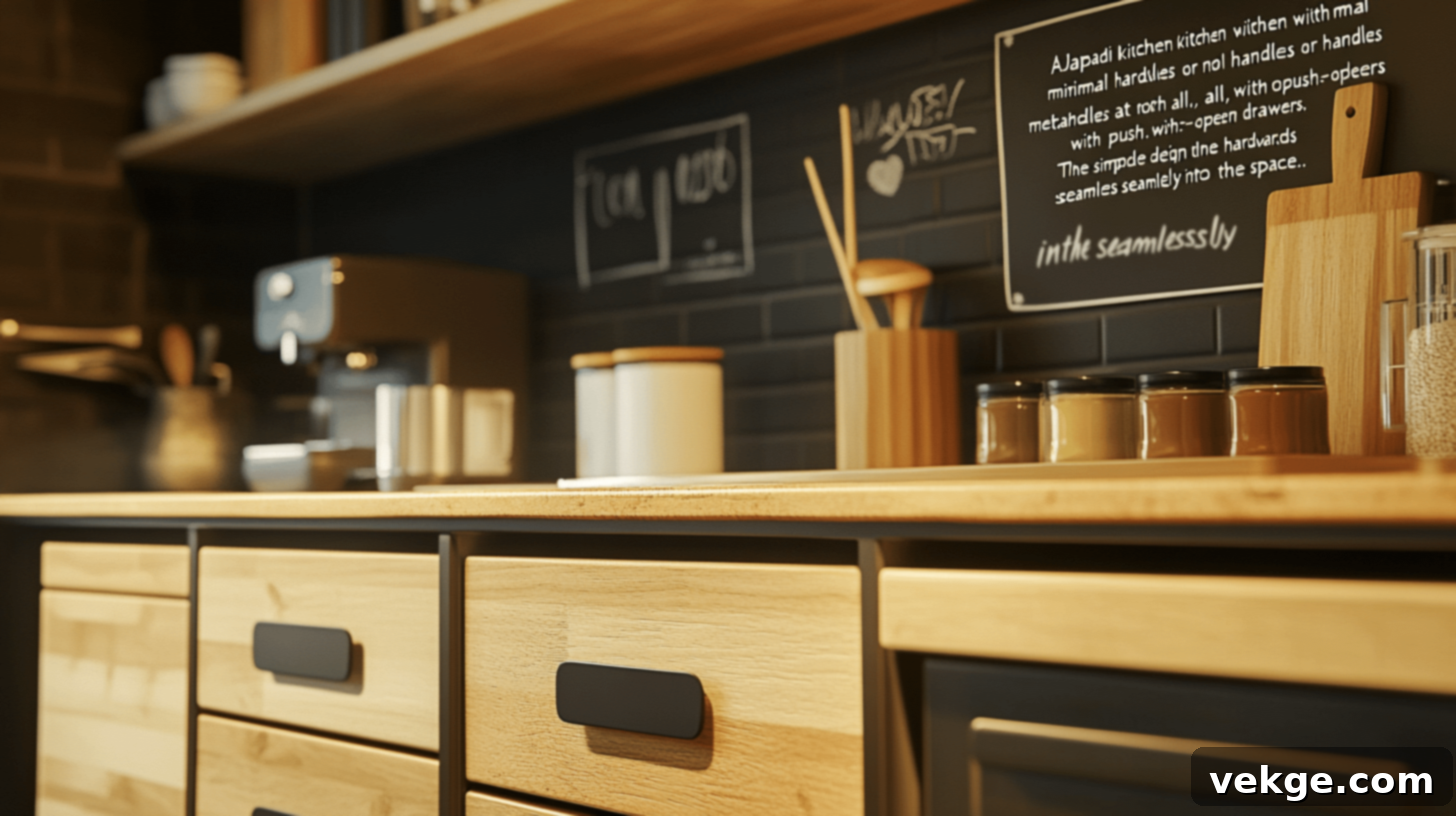
Hardware should be an almost invisible detail in a Japandi kitchen. Choose thin, minimalist handles or pulls in a matte black metal, brushed nickel, or even a subtle brass. For an even cleaner look, consider foregoing handles entirely by installing push-to-open drawer and cabinet mechanisms. Avoid ornate knobs, elaborate pulls, or anything with excessive detailing. The aim is for these small metallic touches to blend into the overall design, allowing the larger surfaces and natural materials to truly shine.
30. Blend Angular and Fluid Shapes Thoughtfully
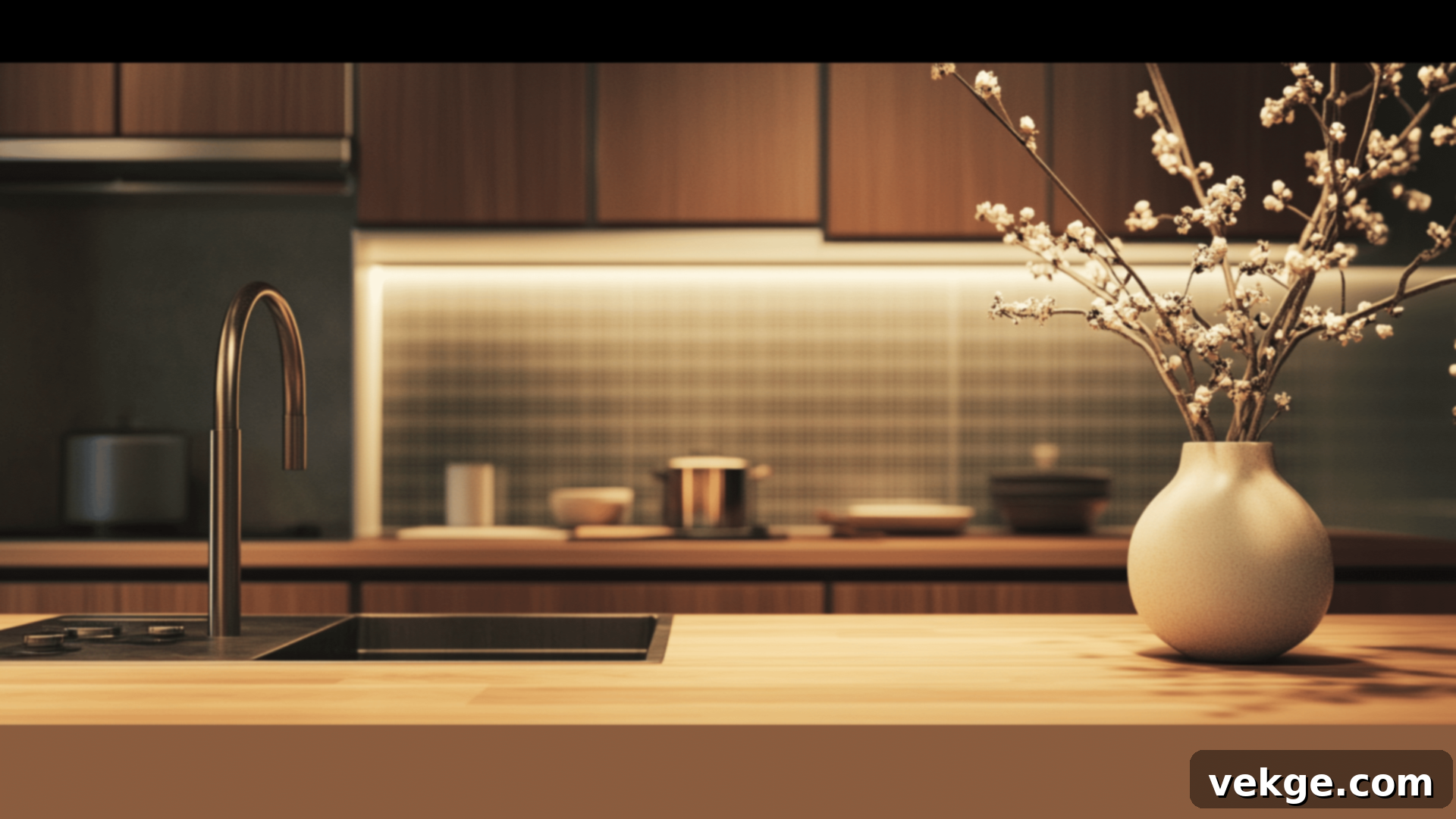
Create dynamic visual interest by juxtaposing sharp, angular forms with soft, fluid shapes. For instance, pair the straight, clean edges of your cabinets and island with a beautifully rounded ceramic vase, a curved kitchen faucet, or an organic-shaped serving platter. This deliberate balance of hard and soft lines adds visual depth and sophistication. It prevents the space from feeling too stark or rigid, contributing to the gentle harmony that makes Japandi design so uniquely appealing and calming.
31. Mix Warm and Cool Tones for Depth
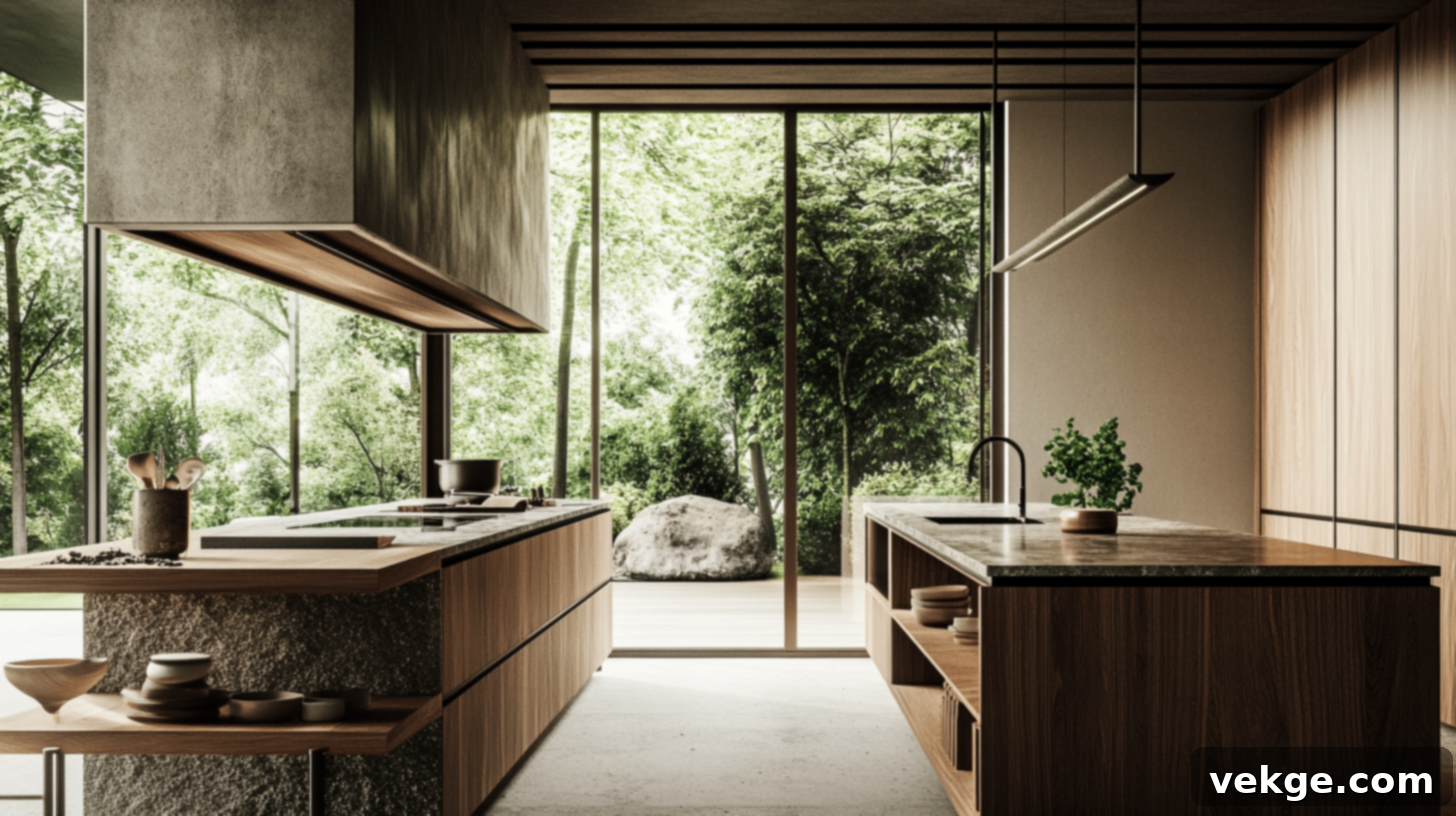
An effective way to add sophistication and natural appeal to your Japandi kitchen is by strategically mixing warm and cool tones. Pair the inherent warmth of natural wood cabinetry or flooring with the cool, crispness of stone, concrete, or a cool-toned paint color. This thoughtful contrast allows both materials to stand out more vividly and creates a richer, more textured visual experience. It mimics natural landscapes, like a forest floor meeting a rocky outcrop, making the space feel more organic and layered.
32. Avoid Intricate Structures and Ornate Fixtures
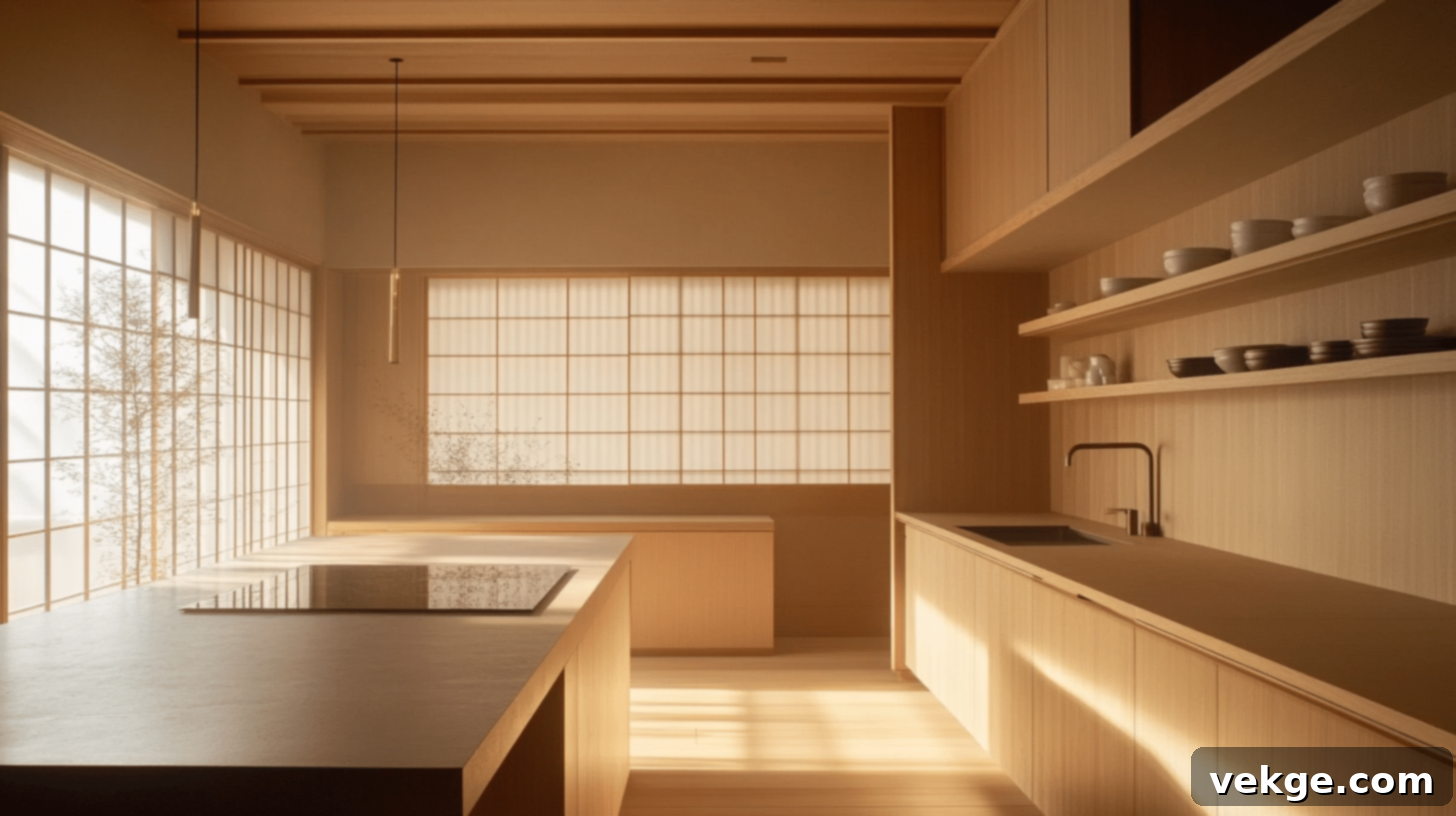
To maintain the clean, serene aesthetic of Japandi design, steer clear of overly elaborate architectural details and decorative fixtures. This means avoiding fancy crown molding, highly detailed cabinet doors, or complex lighting designs. Instead, choose flat-panel cabinet fronts, clean-lined skirting boards, and simple, functional fixtures. This minimalist approach allows the inherent quality and natural beauty of your chosen materials to become the focal point, fostering an uninterrupted sense of calm and refinement throughout the entire room.
33. Try Stone Slab Walls or Backsplash for Seamless Beauty
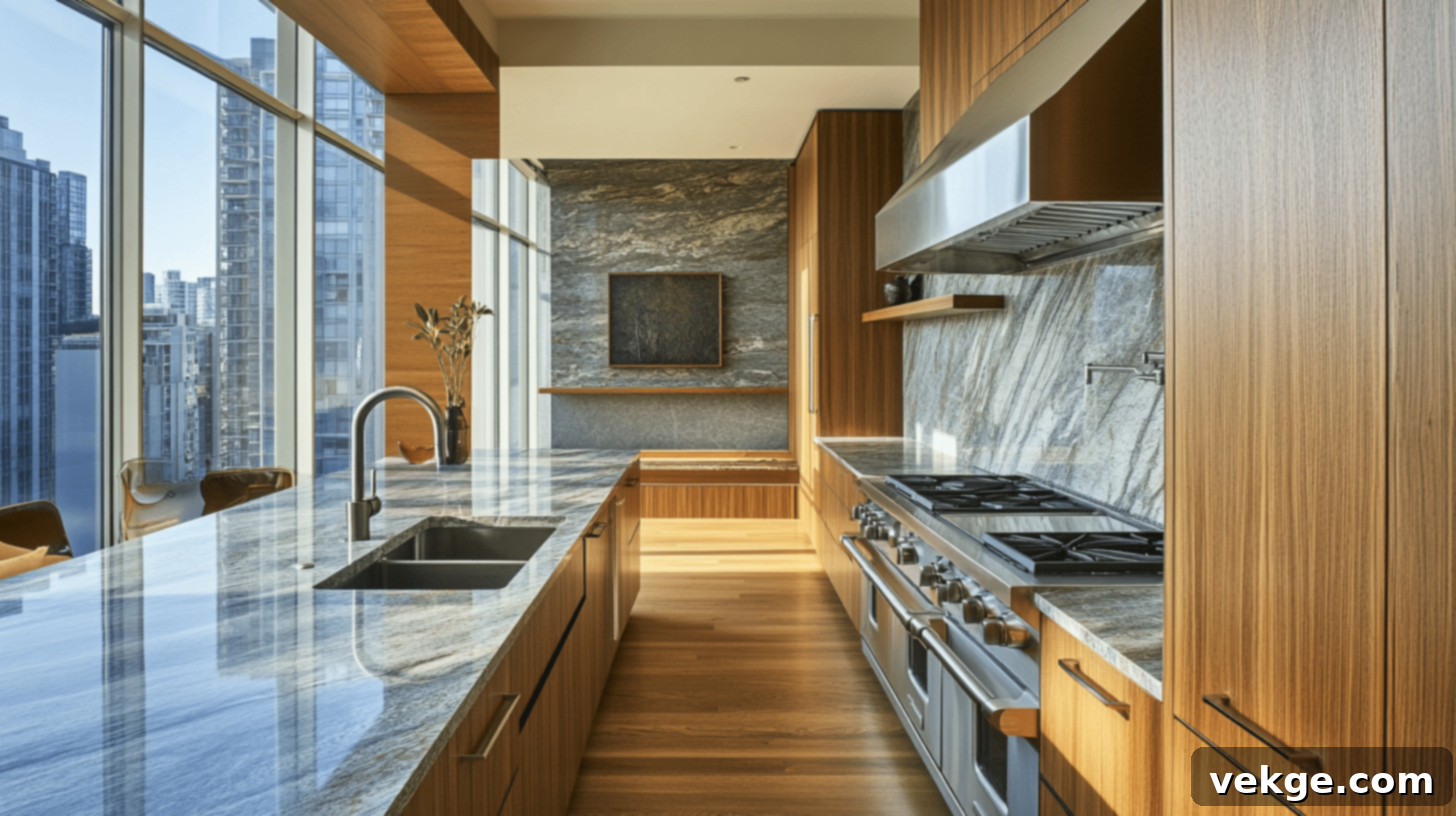
For an elevated and incredibly clean look, consider using a single, large slab of natural stone instead of multiple tiles for your kitchen backsplash or even an accent wall. The absence of grout lines creates a seamless, expansive surface that is both visually stunning and incredibly easy to clean. Choose a stone with subtle, natural patterns or delicate veining that harmonizes with your wood grain, rather than competing with it, allowing the material’s inherent beauty to make a powerful yet understated statement.
34. Don’t Fear Mixing Wood Types
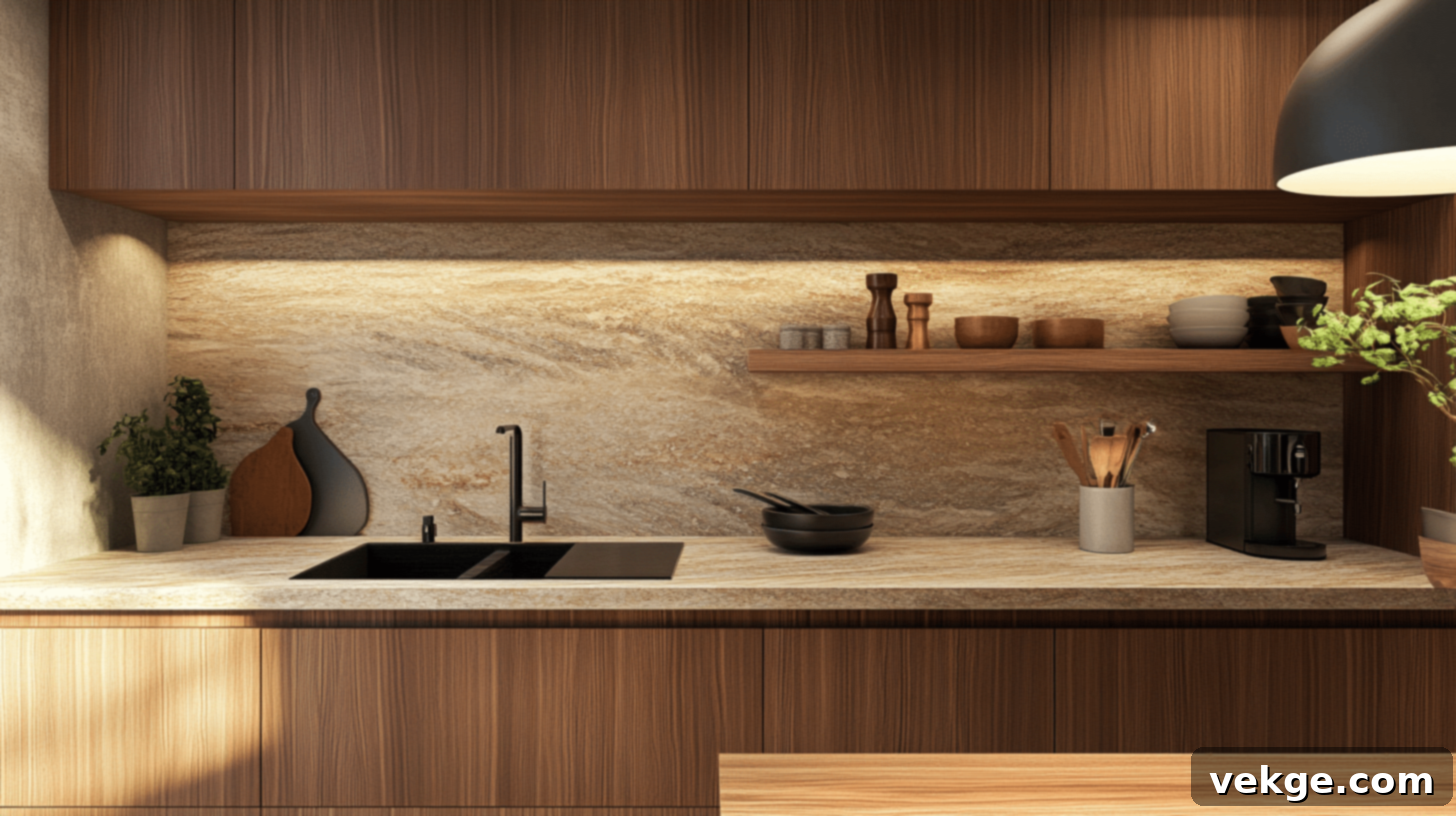
Mixing different types of wood can add significant depth and character to your Japandi kitchen. Feel free to combine light woods like birch or ash with darker varieties such as walnut or darker oak. The key is to maintain a similar grain pattern – either all straight-grained or all swirly/figured – to ensure visual cohesion. This deliberate combination creates rich visual interest and a layered feel, all while upholding the natural, authentic essence of Japandi design.
35. Choose the Right Tone of Color
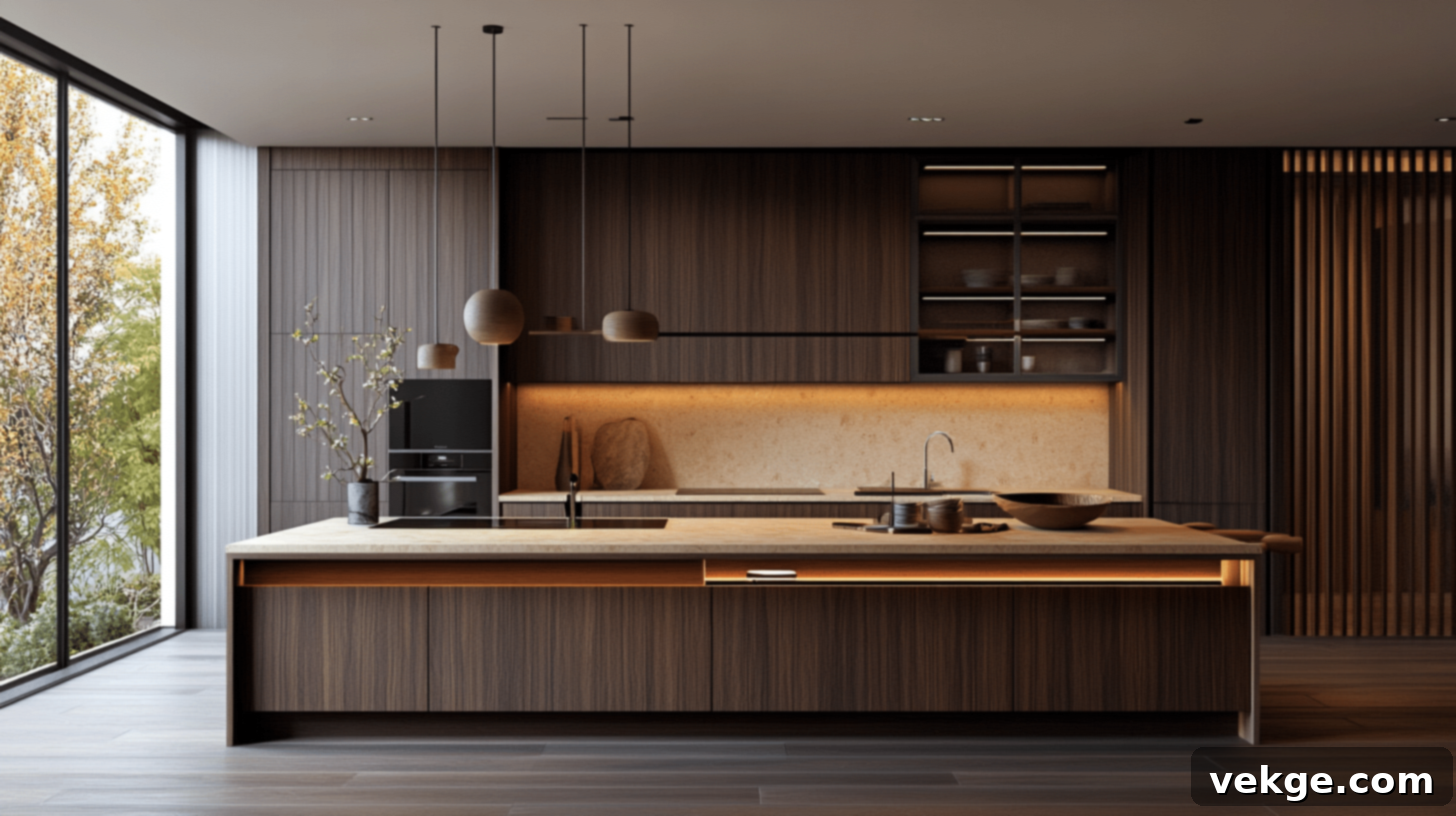
When selecting colors beyond your primary neutrals, pay close attention to their undertones. Opt for muted shades that have subtle gray undertones rather than overly warm, bright, or saturated hues. Soft, desaturated greens, dusty blues, or earthy terracotta will feel more organic, calming, and sophisticated. These subdued tones integrate much more seamlessly with the natural wood elements and stone, contributing to the overall serene and harmonious atmosphere that defines Japandi spaces.
36. Maintain a Consistent Flow Throughout
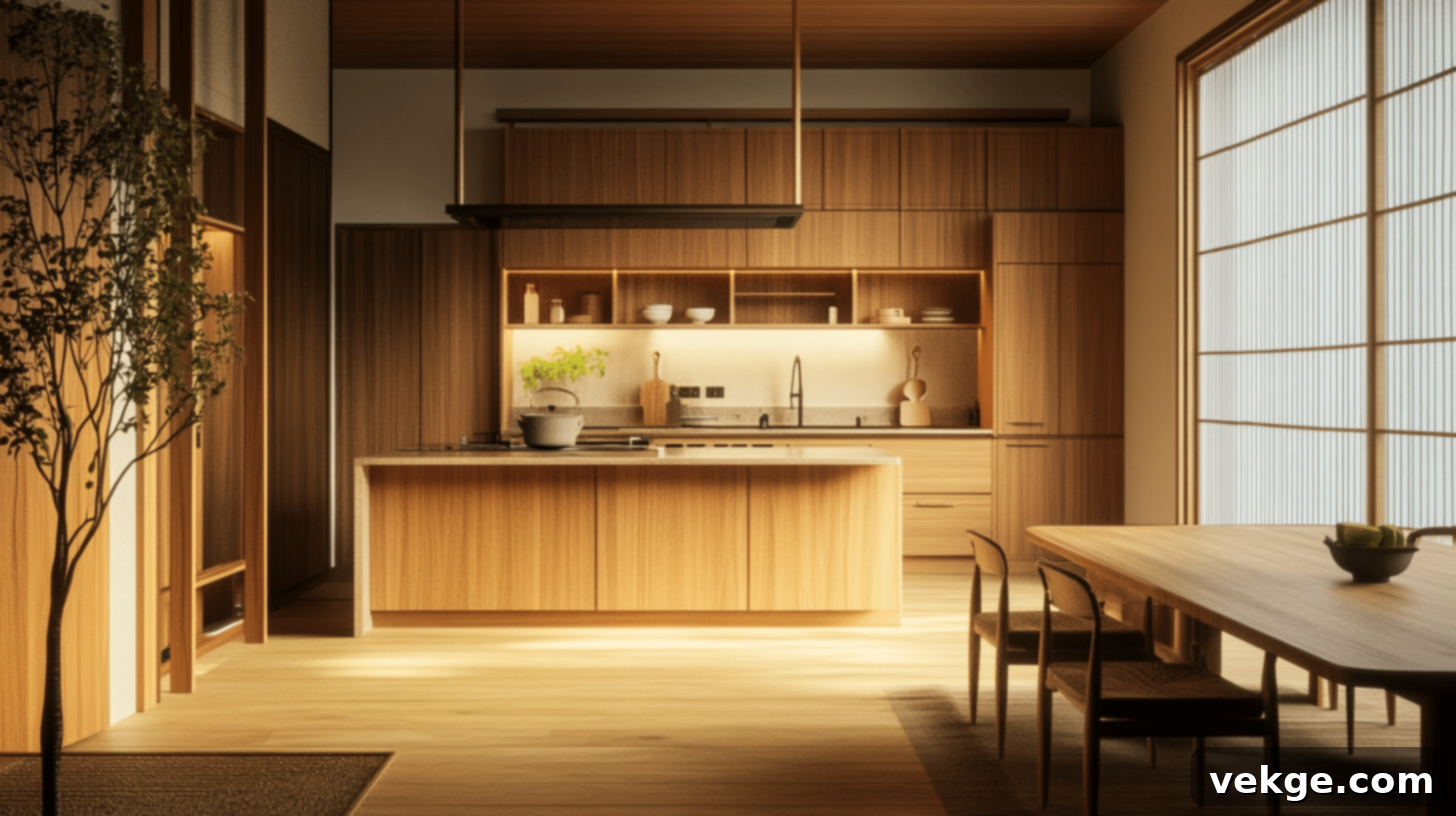
A key aspect of Japandi design is creating a continuous, uninterrupted flow that promotes a sense of calm. Ensure cabinet heights are consistently aligned across different walls, and where possible, use the same flooring material throughout your kitchen and any adjacent open-plan living areas. This visual continuity minimizes disruptions, creates a sense of spaciousness, and makes your kitchen feel like an integral, thoughtfully designed part of a larger, well-planned home environment.
37. Incorporate Authentic Japanese Elements
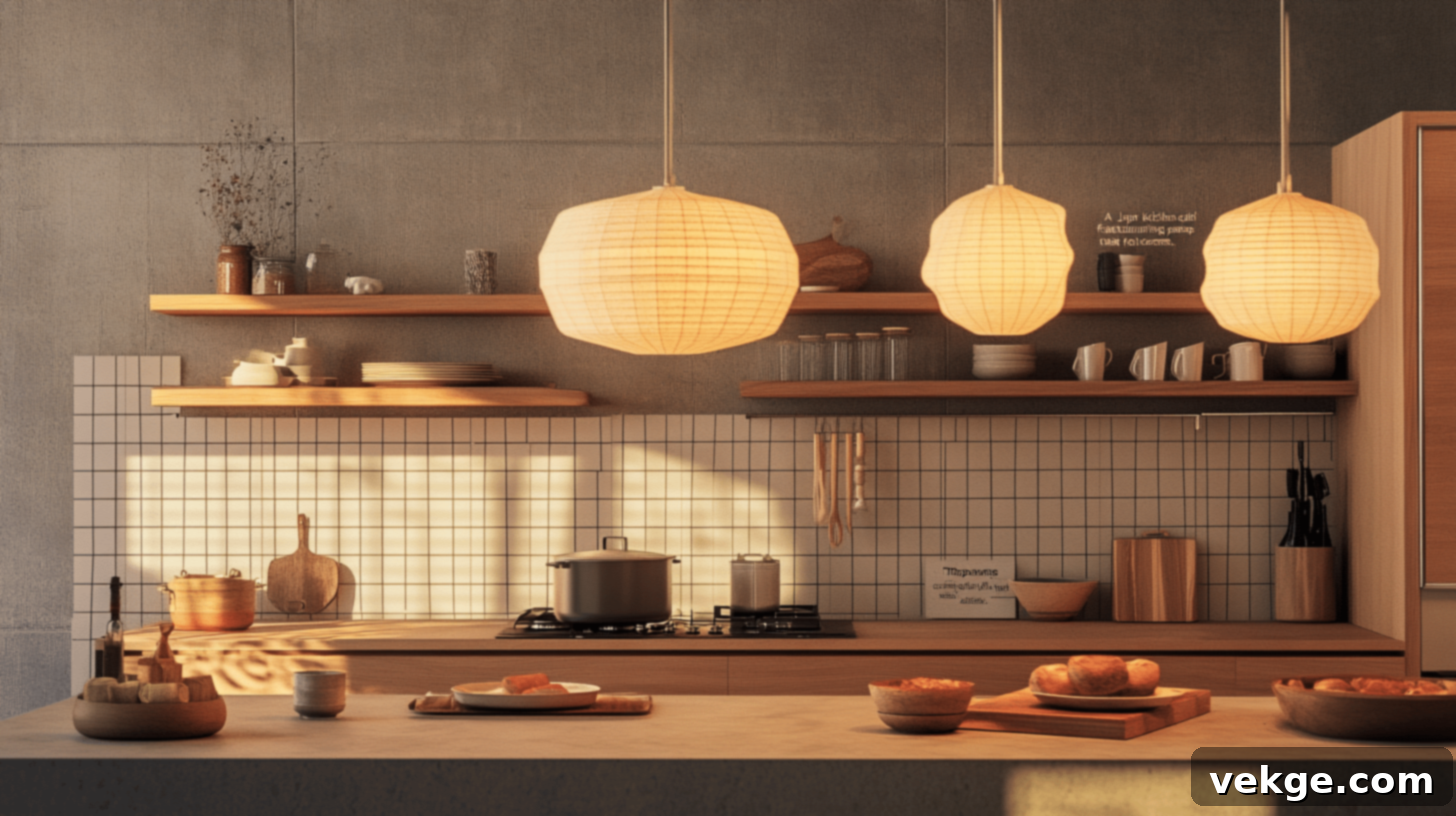
To honor the Japanese roots of Japandi, integrate subtle yet authentic Japanese elements. Consider elegant washi paper lamp shades that diffuse light beautifully, or sliding shoji screen-inspired room dividers to delineate spaces. Use simple, handcrafted ceramic tiles with slight variations in color or texture, reflecting the beauty of imperfection. These carefully chosen elements subtly nod to Japanese craftsmanship and aesthetics without transforming your kitchen into an overly themed space, maintaining balance and elegance.
Essential Tips for Achieving Authentic Japandi Design
Beyond individual ideas, here are some overarching tips to successfully implement the Japandi aesthetic in your kitchen:
- **Declutter First:** Before introducing any design elements, ensure your kitchen is thoroughly decluttered. Start with a clean, functional, and organized base to truly embrace the minimalist spirit.
- **Contrast & Balance:** Master the art of contrast by mixing light woods with darker accents (like black metal or dark stone). This creates visual balance and adds appealing depth without complexity.
- **Seamless Transitions:** Establish a smooth, continuous flow between different kitchen zones and adjoining spaces by utilizing consistent materials, color palettes, and design language.
- **Personal & Purposeful Decor:** Limit decorative items to one or two personal pieces that hold meaning or serve a distinct purpose. Avoid overcrowding surfaces to maintain visual serenity.
- **Hidden Functionality:** Prioritize integrated appliances and clever storage solutions that keep everyday items and technology out of sight. This maintains clean sightlines and enhances the minimalist feel.
Incorporating Japandi with Other Kitchen Styles
One of Japandi’s strengths is its adaptability. Learn how its core design principles can be harmoniously combined with various other styles to create unique kitchen spaces that remain balanced, functional, and infused with simplicity.
Japandi and Modern Design
The synergy between Japandi and modern design is natural, given their shared emphasis on clean lines and simple forms. Combine them by featuring sleek, handleless cabinet fronts on beautiful natural wood doors. Introduce concrete countertops or polished black stainless steel appliances for a contemporary edge, while retaining warm wood flooring or accents to ensure the space feels inviting. The result is a kitchen that is refreshingly clean and current, yet never cold or sterile.
Japandi and Mid-Century Modern
Mid-century modern pieces, with their organic curves and use of warm woods, integrate beautifully with Japandi. Incorporate classic mid-century bar stools with their distinctive thin wooden legs at a Japandi-style island. Maintain the warm wood tones as a primary element, but limit the bolder, saturated colors often found in mid-century design to just one or two small, carefully chosen accents. The graceful, curved shapes of mid-century furniture will add a welcome softness to Japandi’s predominantly straight lines, creating a sophisticated and comfortable blend.
Japandi and Bohemian Style
To fuse Japandi with the free-spirited bohemian style, exercise restraint. Limit the wide array of boho colors to just two or three soft, earthy shades that complement your neutral Japandi base. Keep natural wood tones as your foundational element. Instead of many decorative items, choose one striking textured wall hanging, a single patterned rug made from natural fibers, or a few artisanal ceramic pieces. Emphasize plants as your main decorative element to bridge both styles, using their organic forms to add a lush, natural touch.
Japandi and Rustic Style
Blending Japandi with rustic style creates a kitchen rich in natural texture and warmth. Pair rough-hewn wooden beams or a reclaimed wood island top with the smooth, refined surfaces of Japandi cabinetry. Opt for metals in dark, matte finishes like oil-rubbed bronze or blackened steel for hardware and fixtures. Select natural stone with visible imperfections and unique marks. This combination adds a sense of history, authenticity, and groundedness to your kitchen, all while maintaining the clean, intentional planning characteristic of Japandi.
Japandi and Contemporary Style
Introduce contemporary flair to your Japandi kitchen by adding hints of sleek glass and polished metal. Use these materials sparingly, perhaps in a minimalist pendant light with a glass shade, or in the legs of a modern bar stool. While favoring simple shapes, allow for one subtly curved statement piece, such as a sculptural vase or an elegantly arched faucet. Utilize black as a powerful accent color rather than a dominant one, ensuring the overall balance and serenity of the Japandi aesthetic is preserved.
Japandi and Traditional Japanese Style
To lean into the Japanese roots, incorporate elements with clear reverence for traditional Japanese aesthetics. Consider using sliding shoji-inspired screens or beautifully crafted wooden room dividers to subtly separate kitchen zones. Introduce one or two authentic Japanese items, such as a traditional tea set, a simple bamboo-woven basket, or a wooden rice container, as purposeful decor. Keep paper lanterns simple in form, free of elaborate patterns, and chosen for their soft, ambient light, creating an atmosphere of deep tranquility and cultural appreciation.
Common Mistakes to Avoid in Japandi Kitchen Design
While Japandi design seems straightforward, it’s easy to make missteps. Be mindful of these common pitfalls:
- **Overcomplicating the Design:** Introducing too many different materials, patterns, or colors can quickly disrupt the serene and simple nature of Japandi. Stick to a curated selection.
- **Clashing Elements:** Using overly vibrant colors, elaborate fixtures, or highly ornate decorative items will directly contradict the calm and understated philosophy of Japandi.
- **Neglecting Functionality:** Prioritizing aesthetics above practical use can result in a beautiful but frustrating kitchen. Ensure your design is highly functional and easy to navigate.
- **Excessive Decor:** The Japandi ethos champions minimalism. Adding too many decorative items, even if individually beautiful, will create visual clutter and diminish the sense of openness.
- **Chasing Trends:** While modern, Japandi emphasizes timelessness. Choosing overly trendy elements that will quickly fall out of style can undermine the enduring appeal of the design. Focus on quality and longevity.
Maintenance and Sustainability in Your Japandi Kitchen
Maintaining a Japandi kitchen aligns perfectly with its philosophy of appreciating natural materials and mindful living. Regular care ensures the longevity and beauty of your chosen elements. This typically involves periodically oiling wooden surfaces to protect and nourish them, and promptly cleaning spills on stone or concrete to prevent staining. Embrace the natural aging process of materials, as subtle wear can add character, embodying the wabi-sabi appreciation for imperfection.
For a truly sustainable Japandi kitchen, make eco-conscious choices during selection. Opt for materials such as fast-growing bamboo, reclaimed wood, or locally sourced stone, which have a lower environmental impact. Consider finishes like natural oils, waxes, or low-VOC (volatile organic compound) paints, which are better for indoor air quality and can be easily touched up or renewed over time. Investing in durable, high-quality materials from the outset also contributes to sustainability by reducing the need for frequent replacements, ensuring your kitchen remains beautiful and functional for many years to come.
Wrapping Up: Embrace the Calm of Japandi Kitchen Design
Japandi kitchen design offers a truly unique and refreshing approach to creating a cooking space that is both profoundly useful and exceptionally beautiful. With its unwavering focus on natural materials, clean architectural lines, and a thoughtfully curated, subdued color palette, this elegant style has the power to transform any kitchen into a tranquil sanctuary for culinary creativity and mindful living.
Whether you choose to embark on a full kitchen renovation or simply wish to introduce subtle changes, adopting Japandi principles is accessible. Start small by integrating a few key wooden accessories, upgrading your lighting fixtures to more minimalist designs, or decluttering your countertops. For a more significant transformation, consider new cabinetry in light wood tones or a striking stone backsplash. The inherent beauty of Japandi kitchen design lies in its versatility and adaptability, making it suitable for homes of all sizes and styles.
We encourage you to experiment and integrate just one or two ideas from our extensive list. Witness firsthand how this harmonious fusion of Japanese serenity and Scandinavian comfort can profoundly change the way your kitchen looks, feels, and functions, bringing a new level of calm and sophistication to your everyday life.
